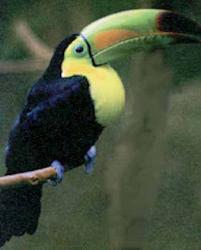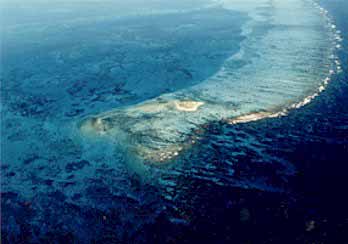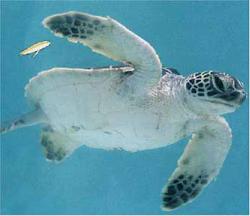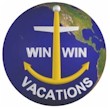February 07-17, 2003
7
nights cruising from the Yucatan Peninsula to
Belize, Guatemala and Honduras on the Star Clipper
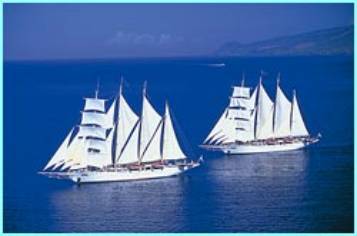
Twin
ships of identical elegance
Star Clipper and Star Flyer
Stars of the Seas
Star
Clipper and her sister ship Star Flyer are as fleet as the wind and as graceful
as swans. These are true clipper ships, reflecting their proud heritage in every
inch of polished brass and gleaming bright work.
Star Clippers Cruises’ ships explore exotic regions not usually visited by cruise ships. If you've ever turned misty-eyed when watching a stately procession of tall ships, Star Clippers Cruises may be the perfect cruise experience for you.
The owner Mikael Krafft, born and raised near a shipyard in Sweden, constructed two identical steel hulled clipper ships that offer the rare opportunity to cruise the Caribbean, Mediterranean and Far East aboard the swiftest and largest clipper ships ever built. Each is powered by 36,000 square feet of sail from four masts, including five giant square sails on the foremast (a diesel engine is in reserve for calms and for maneuvering in port). The ships are modern, high-tech, re-creations of the classic clipper sailing ships that dominated the oceans of the world in the 19th century.
During
a leisurely Caribbean cruise, while anchored one sunset off St. Martin in 1987
aboard the "Gloria", suddenly, as he recalls, "all the pieces
came together" and his long nourished clipper ship dream fell into place:
he would build not one but two of them, and thus have a viable business
proposition, a real cruise line. He knew in his heart passengers would rally to
the concept of comfortable sailing on traditional major clipper ships, built to
uncompromising yacht safety and appearance standards.
To
get ready for construction took three full years of intense clipper ship
research, some of it studying carefully preserved original plans for ships of
the mid-19th century. Construction started in 1990 at a fine Belgian shipyard,
the Belgian Shipbuilders Corporation Yard at Ghent. This was to be the first new
clipper ship of the 90 years of this century. She would be a vessel so huge for
her type that she would be the largest clipper ship in history. The result was
360-foot "Star Flyer", launched in May 1991, followed a year later by
her identical twin, "Star Clipper".
Since
their introduction the ships have sailed on weekly voyages in the Caribbean, the
Mediterranean, around the Greek Islands and winter voyages out of Phuket,
Thailand.
A
letter from Mikael Krafft
Dear
Traveler,
As
Star Clippers begins a second decade, I am very pleased that our new clipper
ship has successfully entered service. Inspired by the Preussen, the historic
flagship of the famed Flying P Line of Germany, Royal Clipper is a five masted
full rigged sailing ship. She is the largest true sailing ship in the world.
When Star Clippers was founded, I wanted to fulfill my lifelong dream of
re-creating true sailing clipper ships and have them successfully sail the seas
and oceans of the world. These were the incredibly swift large sailing ships
that opened up international commerce in the 19th century. We began building
Star Flyer in 1989 and she was commissioned in 1991. Star Clipper entered
service in 1992. We recognized the need to create a unique shipboard experience
for these clipper ships. We call our informal yet elegant approach to sailing
the "Mega-Yacht Experience".
I
have been very fortunate in my life to build and own some major sailing
mega-yachts. These are the large private yachts that one sees in the finest
harbors. I had the opportunity to move around the world with my best friends,
feeling a real family atmosphere, while being pampered in comfort with modern
amenities. We would glide silently through the sea under full sail, enjoy
sunbathing and water-sports at a secluded beach, have dinner with the captain,
and chart the next day's sail to a fascinating out of the way port which only
yachts can easily reach.
What
I discovered is by building clipper ships and providing the activities,
amenities and atmosphere of my own yacht, we can offer mega-yacht sailing at a
price which often is less than you would pay for a nice cabin on a typical large
cruise ship. This provides a fabulous alternative to mass market cruising while
being in full harmony with the environment, the sea and away from ports
congested with tourists.
We
look forward to welcoming you on board to participate in the nautical heritage
of clipper sailing ships and to enjoy the unique mega-yacht experience that
keeps so many of our guests coming back time and time again.
Sincerely,
![]()
Mikael
Krafft
Owner
and Chief Executive Officer
Company
Overview
Quality
Rating: 5 Stars
![]()
Value Rating is exceptional
Royal Clipper, Star Clipper and Star Flyer sail some of the most exotic waters of the world. No
matter which itinerary is chosen, you'll bypass the mass-tourism ports and
discover charming, unspoiled islands and ports that really do resemble the
tourist brochures! These include mythic Delphi in Greece and Kusadasi, Turkey
(for a visit to Ephesus); Calvi, Corsica, Palma, Majorca, Portovenere, Italy on
the Mediterranean itineraries; Bequia/St. Vincent and Guadeloupe in the
Caribbean, and Penang, Malaysia and the Similan Islands, Thailand in the Far
East.
Mikael
Kraftt, a Swedish entrepreneur, got his first job at the
Plyms Shipyard near his home in the Stockholm archipelago when he was six years
old. He listened to the stories the old seamen told and his love of sailing
grew. When he was 12 he sailed his own 18-foot boat over 20 miles of open seas
and practiced maritime law in Sweden and France. In 1986 Mikael Krafft sold his
Swedish interests and relocating in Brussels where he founded the White Star
Group of Belgium involved in real estate developments within the Benelux
countries. White Star Group is the parent company of White Star Clippers, which
commissioned Star Flyer and Star Clipper. Mikael Krafft launched the Star Flyer
and Star Clipper in 1991 and 1992 in Ghent, Belgium. They were the first clipper
ships to be granted the certificate of highest quality by Lloyd's Register of
Shipping since 1911.
This
small but healthy company has established a comfortable niche of offering some
of the best one-week itineraries around at prices comparable to and often below
conventional cruise ships. There's also a guaranteed single rate that can be a
terrific lure for those seeking the close camaraderie characteristic of small
ships with a wide range of ages aboard.
Fleet
Overview
Step aboard these unique
vessels and discover a new age of sail, where the traditions of the past are
happily married to the comforts and amenities of the present. Star
Clipper and Star Flyer are
modern cruise ships in every way, created for comfort-loving passengers who also
love the traditions and romance of the legendary era of sailing ships. Star Clipper
and Star Flyer are both 360 feet long and
each carries just 170 guests in pampered comfort. They have 4 masts and 16
sails, a 50-foot long beam, 226 feet mast height, 36,000 sq. feet sail area.
These ships are fast, long, deep, sleek, beautiful, and narrow like a dolphin.
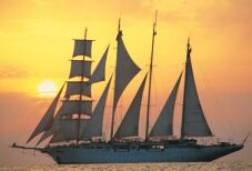
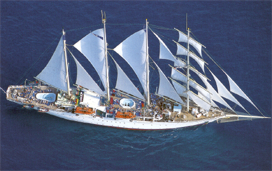
Built
in Belgium in 1992, the Star Clipper ships were cruising's first purpose-built
classic sailing ships. The clipper-style barquentine is a beautiful sight to
behold when cruising under full sails. She
has 5 square sails on the fore mast, which makes her a barquentine. The Star
Clipper is a replica of a 19th century clipper ship providing all the amenities
and atmosphere of a mega-yacht. Gliding along the waters silently under full
sail - all 36,000 sq. ft. of them - is such an impressive sight not only to the
passengers but also to all who come into view of the ship. One of the many
highlights of the voyage is when passengers are given the opportunity to embark
on the tender to see and take photos/video of the Star Clipper under full sail.
It is just breathtaking!
Although the ships are motorized, Star Clippers Cruises ships’ engines are switched off as long as conditions permit, and the crew unfurls 36,000 square feet of billowing sails with the help of all passengers willing to lend a hand, to capture the winds that propel her along at a comfortable 8-10 knots while the music by Vangelis from “1492 – Conquest of Paradise’, the movie of life of Christopher Columbus plays on deck. It’s magical and so very romantic, especially at sunset.
To
build Star Clippers’ two sister sailing cruise ships, the rakish looking,
360-foot barquentines, Star Clipper and
Star Flyer, they studied the hull concepts
and rigging proportions of several of the fastest 19-century vessels, all from
the acclaimed clipper ship designer Donald McKay of East Boston,
Massachusetts. It is a nice coincidence that Hartmann Design had already carved
a figurehead replica from one of McKay’s ships the Glory of the Seas,
for another Swedish costumer from Trelleborg. According to Captain Uli Preusse,
this figurehead blew away at sea during a stormy transatlantic crossing several
years ago and has not been replaced.
The
Star Clipper ships transport passengers back in time to the 19th century when
clipper ships ruled the waves. They currently rank as the tallest Tall Ships in
the world, with a mast that rises 226 feet high. Along with Star
Flyer and Royal Clipper - the
classic Tall Ships that make up the Star Clippers Cruises fleet, the Star
Clipper occupies a select niche of "mega-yachts," offering
passengers the opportunity to experience an authentic sailing adventure that is
the essence of romance on the high seas.
In
July 2000, the largest true sailing ship in the world, the 5,000-ton Royal
Clipper entered the fleet as the largest -- and most beautiful --
full-rigged clipper ship ever built. The ship boats 56,000 sq. feet of sails and
masts reaching a height of 197 feet. Carrying 227 passengers and a crew 106,
Royal Clipper has a spa and health club and a three-deck atrium with circular
staircase. A full 19,000 square feet of open deck and three small pools invite
languid days and nights beneath the sails and stars. Imagine the envious stares
you'll get when sailing majestically out of Nice or Barbados!
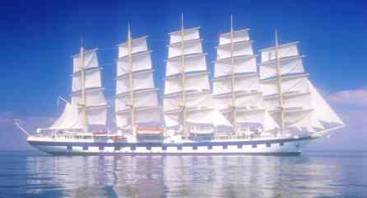
Photo:
Phillipp v. Recklinghausen
They call her the "Queen of Queens", and for a brief period at the turn of the century, the five masted, fully rigged ship the Preussen ruled the sea trades, which were then still open to sailing ships. The great lady was the biggest sailing vessel ever to sail the oceans. Despite this distinction, when she slid down the runway of John Tecklenburg shipyard at Geestemunde, Germany in 1902, in the twilight of commercial sail, no one would have guessed that a century later she would be the inspiration for a new ship. The stuff of legend is the drawing board for Star Clippers, the Monaco-based luxury cruise line that specializes in recreating the sailing vessel experience.
The
Preussen’s specifications were scrutinized for the construction of the
company’s new flagship the Royal Clipper. It is not the first time that Star
Clippers’ Swedish-born managing owner, Mikael Krafft, has cast his eye
back into the history of sail to find a classic style.
The
Star Clipper ships are stabilized by a system of anti-roll tanks and bilge keels
to minimize the ships motion and any discomfort that may be associated with it.
Star Clipper's yacht-like dimensions make her susceptible to "the motion of
the ocean" in rough weather, however. The shipboard information sheet
placed in every cabin notes that "during heavy winds and stormy weather the
ship might list; therefore we kindly ask you to refrain from using showers or
baths as it could cause the drainage system to overflow." Fortunately, the
ship cruises in areas of the Mediterranean and Caribbean where the weather
usually cooperates.
Sea-bands
work well for me to stabilize my equilibrium when I start feeling queasy. They
work on pressure point on the inside of the wrist, like acupuncture, thus there
is no medication needed.
Onboard
Experience
Life
aboard is blissfully relaxed, much like traveling on a private yacht. You never
feel confined as these ships offer pleasingly spacious accommodations and
expansive teak decks with ample space for relaxing and play. In fact, these
ships offer more outdoor space per passenger than most conventional cruise
ships.
When
the romance of sail beckons and a laid-back atmosphere is alluring, these
identical sister-ships deliver a cruise experience unlike any other. The Star
Clipper and the Star Flyer are
stunning and make a dramatic entry into ports of the Caribbean, the Greek
Islands/Turkey and the Far East. Unlike the computerized sailboats of Windstar,
these authentic clipper ships are always under sail, with some help from motors
at times between ports. And unlike Windjammer's fleet, the creature comforts are
fine for those not seeking a luxury experience or nightlife beyond the crew
fashion and talent shows. Activities are low-key and informality is the norm,
with the real drama above deck in the sail experience. At night, passengers
congregate at the topside bar for dancing to live music and chatting with
newfound friends. The entertainment is the crew fashion show or silly games on
deck. A special camaraderie quickly
develops between passengers in a wide range of ages and nationalities.
You get good food, a great crew, and remote private beaches with lots of water sports. Cabins are small but comfortable. There is a great musician on board. We had Csaba from Hungary, a multi talented artist.
Tours are available in all ports and are reasonably
priced. Drinks are fairly priced: Belgium draft beer cost only $2.50. I found
the wine to be rather expensive, however.
I recommend doing the mast climb. There is nothing else like it on any other cruise ship. Star Clippers Cruises is a bargain and we cannot wait to go again. This is a real sailing ship with most the features of a cruise ship. This is cruising’s best kept secret.
There are 2 swimming pools, located on the Sun Deck, which are filled with seawater. There are portholes on the sides, which extend into the bar below. Yes, you can sip your drinks there and observe the antics going on under the water in the pool above! Can get interesting.
The mix of nationalities is delightful. Each evening everyone gathers around the open-air bar. Around 5:00 PM they bring out wonderful hot and cold snacks, a musician plays and sings, and everyone visits and dances. It is very casual and most people come straight from the pool, stay at the bar an hour and then go clean up for dinner. There is open seating for all meals and no dressing up for dinner, except for pants, which is required in the evening. This is one of the best reasons for cruising on smaller ships.
The
only negative about the ship is the very high thresholds needed on these ships.
They are at least 12" high and sometimes these are located at the top of
the stairs leading from the cabins and there is very little space to get your
balance before the stairs begin. For many people this can be a very scary
venture and it was the only way to get outside when the dining room was closed.
The ship has no elevators.
This is truly a unique cruising experience; an alternative to the mass marketed cruises. On the Star Clipper, you can enjoy the sea in close proximity while sailing to unusual ports which only yachts have access to, hence avoiding the ports congested by tourists departing from the larger cruise ships. This I believe is the most important advantage in choosing a Star Clippers cruise.
Of
special interest to us was the snorkeling. The ship provides free use of
equipment, although I always bring my own snorkel and mask. You keep the
equipment for the entire week and bring it to all the islands you tender at in
order to snorkel off the beaches.
Entertainment
During the day
many passengers join one of the escorted shore excursions offered at most ports,
with guides providing insight into the history and culture of the particular
region. It's a good idea to sign up for excursions as soon as possible since the
more popular ones tend to sell out quickly. Nighttime entertainment consists of
activities such as crab races, pirate night games, talent shows and karaoke, a
crew fashion show and dancing at the Tropical Bar.
The ship does not have a casino and there are no stage shows. Crewmembers are
very talented, however. Kenny from St. Vincent is the carpenter onboard and he
sang and danced like a professional an entire evening. Local entertainers
occasionally come onboard in the evening.
Stop
by the bridge at any time, stand watch as an observer, help with the sails or
simply sit back and enjoy sailing as it used to be. You cannot be bored on a
Star Clippers Cruise.
Décor
Tastefully refined nautical, with ship paintings, brass lamps and wooden stairway. On the top deck it's pure sail: yards of ropes, tall masts and deck chairs for watching the crew hoist sails.
The
décor of Star Clipper and Star Flyer is reminiscent of the grand age of sailing
ships. Antique prints and paintings of famous sailing ships please the eye,
while teak and gleaming mahogany rails are richly reminiscent of Star
Clippers’ proud nautical heritage.
Cuisine
We
were delighted with the quality of the food, the portions, the menu choices, and
the service. We tend to order wine with dinner and we had plenty of choices.
The crew went out of their way to make sure we
were having the best experience possible.
To
encourage the passengers to mingle, breakfast, lunch and dinner are all served
at a single open seating in the mahogany paneled dining room, located on the
Clipper Deck. Seating is available either at tables for eight or booths for six
(there are no tables for two or four). Food is nicely presented and is good in
both quality and quantity as passengers can select from ample breakfast and
lunch buffets. Bakery items, especially the fresh breads and desserts, are
exceptional.
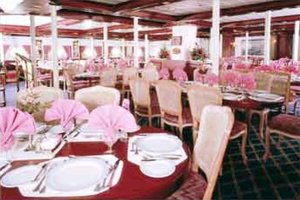
The Clipper Dining Room
Breakfast is a lavish and well- prepared buffet, served
anytime between 8 and 10 AM. Made-to-order eggs and the
omelet bar start the day on a high. There are also plenty of meats, fruits,
cereal, and homemade breads available. Coffee, tea and pastries are also served
in the Piano Bar Lounge from 6:30 AM onwards.
Lunch is served from 12 Noon until 2 PM. There's usually a
side of beef, a turkey or lamb at a carving table along with lots of salads and
vegetables and some creamy desserts and cakes. Lunches are served buffet style
and usually built around a theme, such as Mexican or Chinese. Lunch
was sometimes barbecued on deck and at Tabayana Beach on Roatan, it was served
on the beach.
An
afternoon snack is served daily on the Tropical Deck from 5-6 PM.
A la Carte dinner service begins at 730 PM and ends at 10
PM. No reservations are made to promote conviviality. The
five-course dinner menu offers appetizer, soup, salad and a choice of five
entrees (seafood, meat, chef's special, vegetarian and a light dish) plus
cheeses and desserts. Jumbo
shrimp and caviar were the highlights along with the omelet/egg station in the
morning! It is not unusual to find the crew and captain dining with the
passengers. The French “Savoir Vivre” permits for a leisurely meal.
Service in the dining room is superb -- waiters and the ship's Maitre d’ are warm, friendly and as professional as you'll find on some of the best cruise ships. Shorts are not accepted in the dining room for dinner. Gentlemen are requested to wear shirts with collar and long sleeves for dinner.
Brewed coffee and a selection of teas are available 24 hours in the Piano Bar and there is a fruit-bowl there all day also. Snacks are also offered in the Piano Bar every night at 11:30 p.m. and pastries are served in the mornings. When possible we were anchored during meals.
Alcohol not purchased onboard may only be consumed in your cabin.
The Clipper Dining Room and all other public areas are strictly non-smoking.
Public
Rooms
We enjoyed the convivial
indoor-outdoor Tropical Bar and Piano Bar, and Edwardian style library where a
Belle Époque fireplace glows with a warmth that reflects the friendliness and
enthusiasm of Star Clippers’ hospitable officers and crew.
The library contains a good selection of reading material including paperback
novels, books about nautical history and guide-books featuring destinations on
the itinerary.
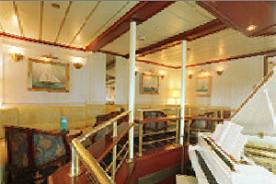
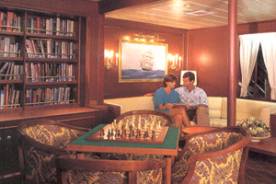
The
atmosphere on the ship is relaxed and casual
The
cozy Piano Bar is easily the most
romantic and intimate room onboard, with its striking white piano, brass lamps
and polished mahogany trim. The room is handsomely furnished with leather
banquettes and chairs, and the walls are adorned with nautical paintings and
prints. Smoking is allowed in here and some people stunk up this room quickly,
which made it unbearable for me to breath in there. Fortunately, the weather was
warm outside and I didn’t need to be in the bar. I missed Scaba playing the
white piano before dinner most evenings due to the smoky conditions in the Piano
Bar.
The
ship's most popular watering hole is the covered outdoor Tropical
Bar where passengers gather in the evenings to socialize and enjoy
beer, wine and cocktails. A BBQ lunch or two are served here during the days at
sea.
Local
entertainers occasionally come onboard and perform on the open deck space
adjacent to the bar. This space is also used for dancing.
On
sea days, passengers have plenty of room to stretch out and relax as the
expansive teak decks provide more outdoor space per person than most
conventional cruise ships.
On-Board activities are minimal except for the already mentioned nightly entertainment of some sort at the Tropical Bar: A Pirate Night, hermit crab racing, talent show, fashion show from the Sloop Shop and trivia contests, Captain Uli's fantastic presentations any time of day and night, mast climbing, 2 pools to dip in, vegetable carving, napkin folding and scuba certification done poolside. You will have to be content with one entertainer/pianist for the week onboard the ship. Scaba was superb and needed no help. He was everywhere with his accordions and pianos.
Water
Sports
You
won't find a spa on these ships, although there are two small pools. On most
mornings an aerobics class is scheduled on deck. There
is no gym onboard so physical fitness activities are limited to these morning
aerobics classes and active shore excursions. A masseuse offers an hour-long
Thai massage for $48.00 as well as manicures and pedicures.
Water-sports
are available, particularly on Caribbean itineraries, including banana boat
rides, windsurfing, water-skiing, snorkeling (complimentary equipment provided)
and scuba diving. The Royal Clipper has a water-sports platform. All
passengers have access to the complimentary water sports program, except for
SCUBA diving. A certification card is required for SCUBA diving and there is a
charge of $48.00 per dive.
Scuba
instructions in the aft pool and introductory dives are also offered.
You
can also lie on the bow nets that hang out on either side of the beam that
extends from the bow of the ship. Just like big hammocks, this was definitely
the place to relax or sunbathe.
Service
The
Cruise Director makes announcements in English, German and French. We had Mara
from Italy and she spoke almost every language on earth fluently. Only urgent
announcements are made in the cabins, however. The restaurant staff is very
pleasant and service is good. Everyone speaks English. Drinks are served at the
bar and on sea days also on the sun deck.
A
PC is available in the library to send e-mail. They go out whenever the
satellite is available and there is no guarantee as to when they reach the
recipient. It’s also expensive. The purser can send a fax also.
Service
and creature comforts are more than adequate, although there is no room service
due to necessary limitations on the number of crew these ships can carry. We had
75 crewmembers from 27 different countries. There are no laundry facilities
onboard, but you can have your dirty laundry done for a small charge: $2.00 for
a shirt, $1.50 for T-shirts, $3.00 for long-sleeved dress shirts, skirts or a
blouse, $4.50 for a dress, 50 cents for socks and underwear, $1.50 for a pair of
shorts. A price list and laundry bag is placed in each cabin.
Medical Assistance
A
nurse is available at all times. A doctor’s visit may be arranged in any port
of call.
Tipping
Gratuities are not included
in the fare and are at the sole discretion of each passenger. It
is suggested that each passenger tip $8 per day -- $5 for the waiters and $3 for
the cabin steward. Tips may be placed in envelopes and handed in to the purser's
office or they may be pre paid with your cruise fare or added to your statement.
A 15% tip is added to the bar bill when ordering drinks.
Fellow
Passengers
In the Caribbean, the
passenger mix is approximately half American/Canadian and half European. On our
cruise with 150 passengers, we had 62 Americans, 36 Germans, 14 Brits, 12
French, 5 Swiss, $ Dutch, 2 Belgians and 2 Norwegians, and 1 each from Austria,
Australia, Columbia, Mexico, Sweden and Turkey. We had 65 repeaters, 3 Honeymoon
couples, people celebrating retirements, birthdays, and us celebrating the last
kid graduating from college.
On Asia and European
cruises, fellow passengers are primarily European and predominately English and
German. Children aged seven or eight and above have a marvelous time aboard
these ships, but don't expect activities designed specifically for them. We had
a 6 year old and a 12 year old onboard our cruise and they had a great time.
Star Clippers
Cruises tend to attracts a mix of ages from young honeymooners to couples in
their 60’s and 70’s. On the whole it's an active, energetic and physically
fit group of passengers with few couch potatoes. Most are seasoned travelers,
and many have a sailing background. The Star Clipper inspires passionate loyalty
among past passengers and there are usually a large number of repeaters
(50-75%).
I
would highly recommend Star Clippers Cruises to those not seeking Broadway type
entertainment, casino gambling and disco style nightlife. A highlight is the
port talks, the crew fashion show of T-shirts and shorts and the talent show. We
had extremely gifted crewmembers entertain us at night on the Tropical Deck from
the carpenter to the bartender and chief engineer.
The
whole focus of these vessels is the pure sail experience and the easy mixing
with fellow passengers representing several nationalities and a broad range of
ages. Clipper cruises are
best for people, who want an authentic sail experience, small ports that large
vessels can't visit, a laid-back atmosphere, meeting new friends, and casual
attire. People, who prefer large-ship activities, casinos, spas, floorshows,
large cabins, formal dining, and dressing up for dinner, should avoid clipper
cruises.
If
you have a pre- existing medical condition that could require professional help
there is a nurse onboard, who can dispense
seasickness medication. I don't recommend these ships if you have a medical
condition that could erupt into an emergency,
although a physician is always present aboard a lengthy trans-ocean voyage.
It
is a one-of-a-kind cruise adventure that appeals to yachtsmen and those who love
to sail. This is not a Windjammer-type experience – the passengers are well
traveled, educated, and sophisticated, although many Star Clippers repeaters
also enjoy sailing with the Windjammer ships.
Children's
Facilities
There are no children's
facilities, but you will find passengers with children aged six and above aboard
some sailings. Children's programs do not exist. A recent
summer cruise saw 17 kids aboard and the cruise staff hustled to create
scavenger's hunts, buy coloring books and provide videos. Counselors are not
part of staff and the ships really are not advisable for children under 8.
Infant needs - including cribs, high chairs and diapers and formula -- are not
available on board. Children eat with their parents with no children's menus.
Pregnant women in third trimester cannot sail.
Attire
An informal
onboard atmosphere prevails at all times and casual attire can be worn at
breakfast and lunch. Recommended dinner dress for women are sundresses, skirts
or slacks. Shorts and t-shirts are not permitted in the dining room in the
evening. At
night, men wear pants and a dress shirt. There
is no need to bring formal wear. There
are no formal evenings. Jackets are welcome for Captain’s dinner, but not
required. About half of the men wore a tie and a jacket, but some wore
short-sleeved shirts or even golf shirts.
Here,
the lure is the experience of being under sail. Those seeking casino, evening
entertainment and dressing up for dinner should look elsewhere. Just bring
walking shorts, bathing attire with cover-ups, reef shoes, skirts, light pants,
a light sweater and hats are recommended. For shore excursions, bring
comfortable walking/hiking shoes and bug repellent. Many of the islands are
remote and unspoiled to the point that they have no pier facilities to receive
the ship’s tender. Zodiacs will transfer guests directly to the beach,
involving some wading in the water, called a wet landing. Bring appropriate
footwear.
Cabins
There are six cabin categories distributed on the ship's
four decks plus one owner's suite on Clipper Deck. Top-of-the-line
accommodations are the eight Category 1 Deluxe cabins located on Sun (1) and
Main deck (2), which are the only cabins with a whirlpool bath and a minibar.
Category 2, 3 and 4 cabins are located on Clipper deck (3) and Commodore deck
(4), and while they measure 120-130 square feet, the use of mirrors makes them
appear larger. All cabins are air-conditioned and furnished using queen or twin
beds plus a desk with a stool, a built in stuffed chair, a radio and a color TV
with scheduled movies. There are 2 channels showing 5 movies
per day, one in German and one in French throughout the day and night. There is
a telephone for calling cabin to cabin and a direct dial satellite phone is
located in the library. Prepaid phone cards can be purchased from the purser.
There is a safety deposit box in the closet.
There is plenty of closet and drawer space for
storage of the type of clothing worn during the cruise.
Bathrooms are equipped with a hand-held shower, a medicine
cabinet and hair dryer. The 3 mirrors above the sink can be arranged so that you see yourself in
the back by using the mirror on the medicine cabinet. In order to preserve water
(this is a sailboat, remember!), the flow of the faucet is regulated to last
only 15 seconds or so, and you must keep pushing a button to get more water.
Bathroom amenities include shampoo, soap, bath-gel, lotion,
shower-cap, a sewing-kit, and cotton. There is no conditioner, so bring your own
if you need this item.
Due
to the design of a classic sailboat, Star Clipper's cabins are not uniform in
size and layout. The best staterooms found on Clipper Deck, are around 130
square feet, attractive and superbly designed. The use of mirrors and wood
paneling makes the space appear much larger. The cabins have one porthole, and
sometimes as we sailed along water would splash onto the window and whirl around
like the water in a frontloading washing machine. The best cabins on Commodore
Deck are l08-116, located midship. There are no handicap staterooms or
elevators. The room steward is excellent and keeps the cabin spotless, providing
clean towels twice daily, unless you hang them up, which indicates that you are
willing to reuse it. There is space under the bed to store suitcases.
Beach towels are provided daily in the cabin and we often
found them hanging on the outside doorknob in the morning, still warm.
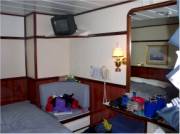
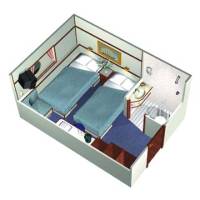
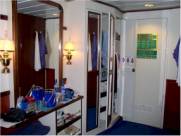
Category
3:
Cabin No # 115 on Commodore Deck is ours
The
accommodations are comfortable. We were in a category 3 cabin, #115, which
consisted of a roomy double bed with shower in the bathroom. Loved it when the
waves splashed the porthole as we sailed along. For the amount of time we spent
in our cabin this was more than sufficient. The ship does use its engines during
the night sometimes to get to its destination by early morning so depending on
where your cabin is situated you may find it noisy. The six inside cabins, category 5 and 6 located on
Commodore and Clipper decks, contain upper and lower berths and do not have a
television.
Unless you're a serious yachtsman, inside cabins are too tiny and claustrophobic
for most people.
Each cabin is equipped with 110-volt, 60 cycle outlets
that do not require the use of special adapters or converters for US passengers.
(The Royal Clipper has 220-volt outlets and do require converters.)
Star
Clipper versus Windstar versus Windjammer
I like them all, but there are differences. The
itinerary would be the first thing I would look at with any ship. I prefer the
smaller ships mainly because they can stop at the smaller islands that the
larger cruise ships can't access. I don't like the big cruise ship ports that
are overrun with tourists.
The cabins on Star Clipper are much smaller and
less luxurious than on the Windstar ships, but bigger and more luxurious than on
the Windjammer ships. The watersports & scuba programs are basically the
same on Winstar and Star Clippers. You can dive off the ship on either cruise.
It’s convenient not to have to chase down a dive shop. I enjoyed the casual
atmosphere of the Star Clipper. Windstar is a smaller version of a large cruise
ship with an upscale country club’s casual atmosphere and large ship
amenities, including room service. There is no room service on the Star
Clippers. There is a substantial price difference also. Simply, you get what you
pay for most of the time. Windstar has more service and more amenities, but Star
Clipper is an excellent value and a true sailing adventure. Some people prefer
the Windjammer’s Barefoot Cruises smaller ships and laid back attitude, where
the passengers get to work at actually sailing the ship. It’s more of a
“party” ship that attracts more young people, some of whom drag their
bedding up on deck and sleep under the stars. This is especially true for the
singles only cruises.
With
all ships getting into the down-island grove is easy.
Please
don’t bring tuxedoes, gowns, ties or feather boas to these ships.
Our itinerary in the Mayan Caribbean
From the Yucatan Peninsula to
Belize, Guatemala and Honduras,
Star Clipper explores an exotic region not usually visited by large cruise
ships.

Sunday: Playa del Carmen
Monday: At Sea
Tuesday: Cayos Cochinos, Honduras
Wednesday: Roatan, Honduras
Thursday: Belize City and Goff’s Caye, Belize
Friday: Puerto Majahual, Mexico
Saturday: Cozumel, Mexico
The world you’ll discover aboard the Star Clipper as she sails the Mayan Caribbean is unlike any you might encounter on a typical “mass-market” cruise ship.
From Mexico’s Yucatan Peninsula to the necklace of cays and offshore islands fringing Belize, Guatemala and Honduras, Star Clipper takes you on a new adventure, exploring an exotic region unfamiliar to most cruisers. She’ll sail to the shores of ancient Mayan America, the lands we now know as Central America. The water is so clear you might be tempted to breathe it, and lands are so lush you can almost see the flowers grow. It’s a place where divers fill their logbooks with accounts of fantastic underwater exploits while nature-lovers revel in sightings of exotic creatures in orchid-filled rainforests. From the ultra-chic resorts of Cancun and Cozumel to the laid-back ease of the Bay Islands and Belize to the fascinating ruins of Tikal and Tulum, you’ll enjoy a refreshing new experience as Star Clipper fills her sails for the incredible Mayan Caribbean!
Day
1: Friday, February 07, 2003
Travel
All Day
Alaska
Airlines #490 Depart: Seattle/Tacoma at 10:50 a.m. Arrive: Los Angeles at 1:27
p.m. Seats: 12F&D
Alaska
Airlines #84, Depart: Los Angeles at 3:20 p.m. Arrive: Cancun at 10:18 p.m.
Seats: 28A&C
Taxis
are readily available on the island, but there are some features of local taxi
service to be aware of. Taxi rates within the hotel zone will cost you a minimum
of $5 per ride, regardless of the distance. In addition, a discriminatory
pricing system can charge tourists up to double the amount that local people pay
using the taxi service. Always ask your taxi driver for a rate card before
beginning your trip. Taxis will take you to the surrounding sites of
Chichen-Itza and the Riviera Maya for an hourly fee of approximately $30.
From
the airport the fare is fixed at $20.00 per person using a taxi and $9.00 PP
using a “collectivo”, a taxi/shuttle service using a van to get to the hotel
zone. You buy a ticket from a vendor inside the airport as you arrive, but
beware of timeshare sales people. We used this option to get to our hotel, the
Westin Regina.
Bus
travel in
Cancun is the most popular way of getting around town. At a modest 45 cents per
ride, with buses operating from 6am to 10pm daily, you can travel to any major
destination on the Island easily and cheaply.
A moped
can be rented from one of several agencies in town, beginning at $25 per
day. Be aware that traffic in Cancun is heavy, and mopeds are a dangerous
addition to the mix. You must provide a credit card as a security deposit if you
wish to rent a moped in Cancun.
Cancun,
Mexico
2
nights Feb. 07 and 08 at The Westin Regina Resort,
Cancun
Blvd.
Kukulcan KM 20
![]() Cancun
Cancun
![]() Quintana
Roo
Quintana
Roo
![]() Mexico
77500
Mexico
77500
Phone(52)(998) 848 7400
![]() Fax(52)(998)
885 0296
Fax(52)(998)
885 0296
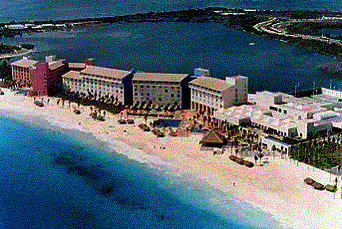
Westin Regina Resort, Cancun, Mexico
Though
only minutes from Cancún's energetic nightlife, The Westin Regina Resort Cancun
enjoys a tranquil setting along an unspoiled beach overlooking the turquoise
Caribbean Sea. Just up the beach from the
Punta Nizuc natural reef, The Westin Regina Resort is perfectly situated to take
full advantage of all Cancún's natural wonders. Through the use of ravishing
Mexican hues, seductive materials and alluring textiles, we have created a warm,
appealing milieu throughout the hotel. Each of our 385 rooms have been designed
as intimate yet lavish spaces with panoramic views and all those wonderful
services you have come to expect from Westin Hotels around the world.
Sample
a variety of gourmet Mexican, Italian and international specialties and take in
the spectacular view from the Sunset Bar. Discover every water sport under the
tropical sun from parasailing to water-skiing, test your skills on the nearby
Robert Trent Jones Golf Course and end the day with a margarita - made from one
of over 100 different tequilas - at the Lobby Bar.
Each
room has a magnificent view of the lagoon or the Caribbean. Snorkel, play
tennis, or golf the 18-hole Robert Trent Jones course nearby. You can unwind in
a pool or whirlpool spa, and enjoy seafood and international specialties in the
resort's four restaurants--each with a view of the sea. And a short drive away
are the ruins of Chichén Itzá and El Castillo Pyramid, whose shadows take the
shape of a serpent on two amazing days each year.
With pools and beaches facing both the lagoon and the sea, you can enjoy the
Caribbean sunshine anytime of day at the Westin Regina Resort Cancun. In
addition, we offer magnificent installations and multiple activities: Five
outdoor pools and four Jacuzzis, SPA, Aerobics Center, steam room, sauna and
massage and two lighted tennis courts, an 18-hole golf course only 5 minutes
away plus a Kids Club with supervised activities program and playroom for the
children.
We
got a nice room facing the lagoon and gardens. It was quiet at the Westin and I
was surprised that it seemed to devoid of tourists. I had expected a busy,
bustling resort.
Day 2:
Saturday Feb. 08
Little
more than twenty years ago, Cancun was just a Mayan name, a deserted,
sun-drenched island off the northeast tip of the Yucatan peninsula.
The
magnificent resort city of Cancun now offers visitors over 25,000 rooms in four
and five star hotels as well as all inclusive accommodations that offer package
deals including food, beverage and rooms. Some hotels are Internationally
recognized, but there also small family style hotels that offer first class
service and accommodations.
The main "Hotel Zone" lies along 14 miles of beachfront known as "Cancún Island" within 30 minutes of Cancún International Airport. Properties here face the Bay, the Nichupte Lagoon, or the multi-colored waters of the Caribbean Sea.
Cancun
Island is approximately 16 miles long with the highest point above sea level
being 200 feet. The State of Quintana Roo is located 550 miles south of Miami,
in the Southeastern part of Mexico. Along the coastline of about 540 miles,
there are numerous coral islands and a reef barrier, the second largest in the
world.
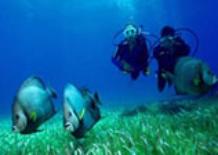 Cancun is a stunning Caribbean paradise with a dual
history, one rich in ancient Mayan influences and Spanish imperialism, and the
other a modern lesson on the growth of this slender island into a fascinating
tourist Mecca.
Cancun is a stunning Caribbean paradise with a dual
history, one rich in ancient Mayan influences and Spanish imperialism, and the
other a modern lesson on the growth of this slender island into a fascinating
tourist Mecca.
In
1967, the government of Mexico began an exhaustive search to find a complete
tourist destination on the Caribbean coast of Mexico. In Cancun, they discovered
a site that had it all: unparalleled natural and cultural beauty highlighted in
the turquoise waters of the Caribbean, the stunning white sand beaches, and the
incredible off-shore reefs. Cancun enjoys 16 miles of beautiful powdery white
sand beaches and an endless view of the Caribbean Sea. Its surrounding waters
are ideal for aquatic sports including snorkeling, diving, and parasailing.
Golfing is also readily accessible year round.
The
surrounding areas are rich with Mayan influences, one of the most advanced
ancient civilizations the world has ever witnessed. The Yucatan Peninsula, on
which Cancun lies, is where the Mayan’s had flourished for centuries prior to
the arrival of the Spaniards in 1519. More than 1200 archeological sites, many
completely restored, are within a few hours drive from Cancun. Popular guided
day tours of the ruins of Tulum, Coba, and Chichen-Itza can be arranged upon
your arrival.
We
walked the beach on the powdery white sand. It felt so good and smooth to walk
on, as the sand caressed our tired feet. We walked from the Westin at very south
end about 5 miles north along the beach before we stopped for lunch. Except for
the Club Med The Westin is the first hotel in the Hotel Zone. The beaches were
not crowded with tourists, as I had envisioned. Cancun too is feeling the
effects of 9/11, the recession and the general “fear” of travel worldwide, I
suppose.
The
beach is fabulous and worth a visit. But the hotels are stacked up one after
another. Amazing!
We
walked through the lobby of the Melia Cancun with the glass pyramid roof and an
exotic rain forest garden inside. It was breathtakingly gorgeous. Across the
street we found the Crab House restaurant facing the lagoon with views of Aqua
World Sports rental boat dock and the activity I the lagoon. The food was OK and
expensive, I had envisioned something Mexican, but apparently the food on Cancun
island is mostly American and Italian. After a small lunch, we walked back from
the JW Marriott hotel. It was a long walk on the fabulous white sand beach. We
spent all day doing this and only covered about a third of the length of the
beach. We will be back before flying home after the cruise for one night.
We
had dinner at the hotel’s Palmar Restaurant outside by the pool. It was a
Mexican buffet and the food was very good, and expensive. I enjoyed the breeze
from the ocean and the sound of the waves splashing onto the shore. It was a
great setting.
Two
distinct landmasses comprise the Cancun region. Ciudad Cancun is on the Yucatan
mainland and features shopping and restaurants, as well as pharmacies, banks,
travel agencies, and other general establishments. It is also the starting point
for many quick trips to the surrounding ruins of the Yucatan. The second region,
Isla Cancun, is the heart of the resort city. Isla Cancun is connected to the
mainland via two bridges, and features opulent resorts, championship golf
courses, deep-sea fishing, diving, amazing beaches, and so much more!
Once
the sun sets, Cancun offers a large selection of entertainment that includes
Mexican-style bars and sophisticated nightclubs, playing anything from salsa
music to modern dance club mixes. Dining in one of Cancun's excellent gourmet
restaurants that offer live dancing and music shows, or browsing through an
exclusive Mexican shopping pavilion. These are just two of the many things you
can look forward to on your visit to this Mexican paradise.
 For
those who go out more for daytime than nighttime sports, Cancun, with its
beaches of powdery coral sand, is the place to be. Cancun is a snorkel and
For
those who go out more for daytime than nighttime sports, Cancun, with its
beaches of powdery coral sand, is the place to be. Cancun is a snorkel and
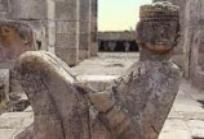 scuba diving paradise, the lagoon enclosed by the -L-
shape of the island, is ideal for sailing and water-skiing. Deep-sea fishing and
diving are fantastic in the open sea, which stretches out in shades of light
green to turquoise from the shoreline to the violet-blue horizon.
scuba diving paradise, the lagoon enclosed by the -L-
shape of the island, is ideal for sailing and water-skiing. Deep-sea fishing and
diving are fantastic in the open sea, which stretches out in shades of light
green to turquoise from the shoreline to the violet-blue horizon.
If
you are searching for calm, peaceful days to enjoy the sun and the sand, Cancun
boasts some of the most beautiful beaches in the world.
If
you prefer to visit the surrounding areas, there are many excursions to the
mysterious Mayan archaeological sites of Tulum, Coba, Chichen Itza or Uxmal
with.
Boat
trips to the nearby islands of Isla Mujeres, Cozumel and Contoy are popular and
easy to do.
Day
3: Sunday Feb. 09
Playa
del Carmen, Mexico
We slept in a little the next morning, had a light breakfast and took another walk on the beach down around the Club Med. They are located at the very end in a calm little cove. It’s a great location, away from hustle and bustle that I envisioned was Cancun, but here again it was not crowded at all. We checked out at 11 AM and took a taxi to Playa del Carmen. The fare is set at $50.00, so that is the price. Be sure to reconfirm that with the driver before you get into the taxi.
The SPV Star Clipper will be anchored at Playa del Carmen, which is located about 45 minutes south of Cancun airport. The big cruise ships’ dock is located at the new Puerto Calica Pier, 8 miles south of downtown Playa Del Carmen. This pier is also used for commercial shipping. There is nothing else here.
The check-in at the Star Clipper hospitality area of the HOTEL MOLCAS begins at noon until 8:00 PM. The Hotel is situated in the pedestrian area of downtown Playa del Carmen. In Playa del Carmen, there are dozens of restaurants to pick from, bars to refresh yourself with a Margarita or cold beer, and stores where you can look for the right souvenir, shop for clothes, or simply look around and get a feel for the place. The taxi could not take us to the door of Hotel Molcas as it is located in the pedestrian zone. We easily found it just 2 short blocks away. We left our bags with the hospitality desk and didn’t see them again until we got to our cabin on the ship. That was convenient. We had all afternoon to enjoy the beach and Playa del Carmen on our own. It was definitely busier here than in Cancun, but not overly crowded. Most people were on the beaches.
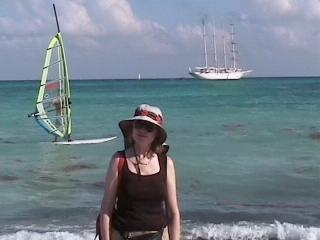
Playa del Carmen truly defines how there is beauty in simplicity. Playa is a quaint town that has been on the brink of rediscovery with its newly built resorts and golf courses. Nothing can be better than being surrounded by the unique flair of local culture, while also having a more modern option as well. The enchantment of the native buildings, with all of the amenities from world-class resorts creates a perfect blend and an ideal cruise destination.
We strolled down Fifth Avenue, the heart of Playa del Carmen. One block from the ocean, it holds an appeal for visitors, inviting them to walk up and down its whole length to absorb the real life of Playa (short for Playa del Carmen). I did a couple of hotel inspections, because I just can’t help myself.
My favorite was the Mosquito Blue, just a few steps off of Fifth Ave on a quiet side street, which I had to see, since my wholesaler recommends it so highly. It’s very nice and clean with a swimming pool and waterfalls inside the garden area. I will stay here on my next visit to Playa.
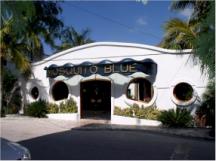
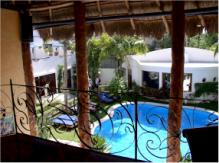
Mosquito Blue Hotel, front from the street and inside from the open library
Partly closed to cars to form a pedestrian thoroughfare, it concentrates most of Playa del Carmen's commercial activity. Fifth Avenue (Avenida Quinta) is most active during the night, when the sun has set. The temperature comes down to a nice, cooler level, and Playa del Carmen's tourists are ready to enjoy a night of vacation leisure after spending all day under the sun or exploring the Riviera Maya.
Playa
del Carmen is a vacation that spoils your senses. The sapphire seaside
invigorates and cleanses the imagination as the white sands dance with you
amidst each perfect sunset. Stroll through picturesque streets uninhibited by
cars and take part in a European atmosphere unique to this part of the Caribbean
coastline. The opportunity to see it all by foot makes it very convenient for
the visitor. There is no need to be constrained to a car, especially when there
is so much to see and experience around every corner.
This
small getaway is the perfect place to find those unique and unusual gifts one
will treasure forever, providing welcoming reminders of an enjoyable vacation.
So take pleasure in the plethora of shops and please your taste buds with the
finest of restaurants. Allow this town to seduce your senses with its European
flair. Situated right in the middle of the Caribbean coast, there is no excuse
not to visit this fascinating land.
For
years, vacationers have been traveling south to the serene and tranquil beaches
of Playa del Carmen. As the largest of the corridor cities, it makes an
excellent base for exploring the jungles, ruins and coastal regions. Many of the
area's accommodations offer a relaxing stay with the convenience of an
all-inclusive plan. This charming town is quite small and perfect to be explored
by foot. However, to get to the many surrounding beaches and golf courses, one
may choose to use a different mode of transportation that is available here. Buses
are found all along the Avenida Principal that is just a brief walk from the
ferry pier, the hotels and the restaurants. Tricycle Taxis are mainly
used to travel between the ferry, bus stations and Avenida 5. They will go
anywhere and fear not, for they can accommodate your entire luggage as well.
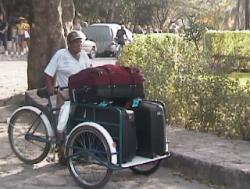
We
stopped at a small restaurant, only 4 tables in the sand on the beach, under
some palm trees and ordered nachos, guacamole and beer. We could see the Star
Clipper anchored outside the reef, and we couldn’t wait to get onboard.
A
little plane was flying around advertising something on a banner, a lobster
dinner I think it was, and then he dropped it into the water. As we strolled the
beach, we saw this heavily laden dugout canoe approaching the shore and a poor
paddler struggling to keep afloat and to move it through the water. He was
bringing back the banner.
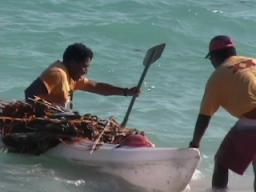
Around
4:30 PM we were transported via the ships own tenders from the Cozumel ferry
dock the ship.
A
welcome drinks and snacks waited for us at the Tropical Bar upon our arrival,
while we checked in and got our knot keys on a ring along with the ships credit
card. Csaba played and the bar was open.
Our
cabin steward, Dimas, escorted us to our cabin. He took care of us for the week
always making sure we had clean towels as requested and a chocolate on the
pillows at night. He also made the sand disappear that we brought with us from
the various beaches during the week to come.
We
feasted on salmon and lamb for dinner the first night and met 2 nice couples
from England.
The
Star Clipper sails at 10:00 PM.

Captain Uli raised the sails and we headed straight south 180 degrees all night.
I will never again hear "1492 - Conquest of Paradise" by Vangelis without envisioning our majestic
Star Clipper ship, all 16 sails taut and full, slicing through that warm Caribbean evening.
In a seamless blend of grace and motion, the Star Clipper is an authentic beauty.
Day
4: Monday Feb. 10
At
Sea all day
The winds blew easterly all night and turned northerly in the morning. We had good winds and sailed all night, but now we had lost the momentum, so Captain Uli decided to get some help from the motor to reach Honduras by the morning. I love sleeping on a ship; it’s so soothing. We had a great buffet breakfast and the captain introduced his crew to us. He also explained what a great experience we would have in the coming week and what to expect, how to take a shower on a sailing ship, etc. His humor is catching.
By now the square sails are useless because the wind doesn’t catch them from the correct angle, he explained. Tall ships, as we know, are as special as they are beautiful. They are as splendid to the eye as they are to sail and it is an unbelievable wonder to sail on them. Watching the guys doing the deck work or taking the opportunity to put your own hands to sheet or halyard next to the deck crew from all over the world is an exhilarating experience. Mikael Krafft, the owner of the Star Clippers—and a schooner man, is giving the general public a chance to go to sea “hands on”. His idea of global tall ship sailing with a multinational crew and inter-national guests on board has made the tall ships available for everybody. The classically designed lines and traditional rigging, combined with top of the range luxury, comfort, safety and high internal standards are the keys for their success. These ships, Star Clipper and Star Flyer are true sailing ships.
There
is a lot to do all day at sea. After the captain’s first speech, we had the
lifeboat drill. Mara explained the shore excursions, and Jeff explained the
diving offered onboard. Everyone got to pick out the snorkel gear that we would
keep for the week. I always bring my own mask and snorkel and only borrow the
fins.
There
is Aqua fitness classes, knot tying classes, an engine room tour and mast
climbing. The bridge is always open and passengers are encouraged to learn how
to sail and “steer” the ship manually.
Captain Uli seems to love to explain to us about the Star Clipper and about sailing ships, and everyone gathers around when he has a small talk. The weather is perfect and people are stretched out in the deck chairs and on the netting in the front of the ship, napping, reading and relaxing in the sun. Soon it’s time for lunch, a Mexican buffet and then cocktails before dinner. The day slipped away too fast.
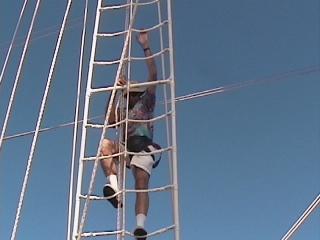
We
couldn’t see the shore, but south of Cancun along the Yucatan peninsula, lie
virtually unspoiled beaches, grottos and ancient ruins of the Tulum Corridor.
Along this eastern coast, the corridor is bursting with scenic and natural
wonders. Visitors can rent jeeps and venture down the well-maintained, two-lane
highway to explore the Palancar Aquarium, the Marin Botanical Gardens, Puerto
Morales and Punta Bete. There are also cenotes, which are unique to
Mexico's Yucatan Peninsula. Cenotes are pools where the water from underground
rivers has come up to the surface, forming a beautiful, natural lake of fresh or
brackish water tightly surrounded by lush, green jungle. They make a perfect
spot for taking a refreshing swim. Cenotes were sacred to the Mayans. It is
where they used to make their sacrifices to the gods, so it is not unusual to
find ancient pottery in them, along with other mysteries they hold. In fact,
cavern and cave diving in cenotes have become very popular in the area. It's
perfectly safe as long as you are going with an expert.
There are various eco parks such as Tres Rios, Xcaret
and Xpu-Ha that offer you a variety of activities on the beach and jungle. A few
of them have small zoos with the animals that are typical the Riviera Maya,
including dolphins that you can swim with.
Soon it was time for evening cocktails and snacks on deck by the Tropical Bar. Then Mara would give a short talk on the next port. Tomorrow we will be in Cochino Grande in the morning. Then the party would move into the Piano Bar an hour before dinner, where Csaba plays the white Grand Piano there. Unfortunately, there were several heavy smokers, who always hang out in the Piano Bar, so I didn’t last long in there. That was too bad for me, as I would have liked to listen to Csaba play the white grand piano.
There is a smoking tolerated zone in the Piano Bar, but it seemed that people smoked everywhere. Finally, I did complain the Jean Paul, the hotel manager and he enforced the rule and then it was a little better.
The Clipper Dining Room and all other public areas are strictly non-smoking.
This evening our choice for dinner is veal scaloppini or filet of sole. They also offer a diet and a vegetarian main course. The chef’s choice is Seabass. There is a display in the Piano Bar of the dishes each night. This is a very clever idea in my opinion. I enjoyed seeing the display.
At 10 PM there is the crew fashion show of the items in the boutique, the Sloop Shop. The supply is getting low, due to the fact that the shipment is held up in the Mexican customs. Seems someone there has decided that a lot of money is due to have the shipment released. It’s not worth it, so the ship is letting it sit there for now. The rules in Mexico can be interesting.
The crew and a couple of the passengers are showing off the wears to music by Csaba of course. Stefan from the Swedish sports team is the biggest clown as he dances and prances around. The sports team is a young and energetic group of Swedes, who are in charge of the beach activities and the gear that goes with it. What a dream job for them, I would think. Sara is only 20 and from Norrköping. This is her first week and she will replace Christian, who is leaving after this week. Also on the sports-team are Jeff and Juan, who make up the dive team. Poppie from Thailand shows how she gives massages, and she was busy all week.
Then the first officer sings Delilah and the bartender sings New York, New York. What a remarkably talented staff we have on this cruise ship.
Day 5: Tuesday Feb.
11
Cochino
Grande, Honduras, The Bay Islands
A string of islands off the northern coast of
Honduras, the Bay Islands are the country’s most popular tourist attraction.
Warm, clear Caribbean waters provide excellent diving on the coral reef. The
white sand beaches, tropical sunsets and the relaxed atmosphere, which
positively encourage you to take your hammock, lay back and relax are equally
enjoyable. The culture is far less Latino than the mainland. Many speak English
and there are still Black Carib descendants, whose ancestors jumped from
stranded slave ships and from those who were deported from St. Vincent in 1797.
We anchored at Atkins Bay around 830 AM A short
downpour greeted us. After a nice breakfast, we were allowed to board the
tenders for the short trip to the dock. The sports team has sailboats and
windsurf activities on the beach for everyone to use. There is good snorkeling
right off the beach too. This is a great spot to spend a lazy day and do not
much of anything.
Cayos Cochinos is Spanish for "hog islands". They got their name for the wild pigs that used to live on these islands. There are 13 small islands in the group of Cayos Cochinos. These islands are located between the island of Roatan and the mainland of Honduras. As Star Clipper threads her way through the gorgeous barrier reef surrounding the Hog Islands, the water is so transparent, you could be convinced the ship was suspended in air! The Smithsonian Institution owns most of the archipelago, so you might expect that it’s unspoiled - in fact, you’ll discover that this is an authentic natural paradise. In the tiny fishing village of Chachauate on Lower monitor Cay, the local hotel is a hammock slung between palm trees. The islands are some of the most beautiful in the Caribbean and form a marine reserve with unspoiled reefs that make for some of the best snorkeling anywhere.
Lying just a few miles off the coast from La Ceiba, Cayos Cochinos can usually be seen from the coast on a clear day. What seems to be a midsize mountain island is actually several different islands. Cayos Cochinos is actually formed by 13 different keys or small islands. Of the 13 keys, two are small islands: Cochino Grande and Cochino Pequeño. Considered as part of the Bay Islands, the keys are the hardest to get to, despite the fact that they are the closest to the mainland.
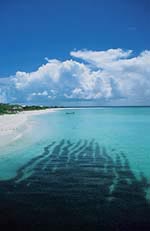
If
you are looking to find one of the most pristine areas in the Western Caribbean,
Cayos Cochinos will prove to be a uniquely beautiful natural reserve that will
be difficult to beat. Cayos Cochinos is a true paradise that fortunately is
being preserved for future generations to enjoy. Diving, snorkeling, hiking and
bird watching are but a few of the alternatives available to the nature lovers
who visit the keys.
The
Honduran Government has declared Cayos Cochinos a Biological Reserve. As such,
law protects it, and anchoring off the reefs is absolutely prohibited, as well
as any type of commercial fishing (there are moorings for the visiting boats and
yachts). The results are already being seen; the fish population is growing
back. Fortunately, due to the difficult access to the keys, its reefs are about
as virgin as could be, having been hardly touched by man. Star Clipper is the
only “cruise” ship allowed to come here.
One
exiting aspect of this marine reserve is the fact that the Smithsonian Institute
has made a 100 year commitment with the Honduran government to help manage the
park and conduct a very serious scientific study of the reef and its sustainable
development. As such, the park is actually patrolled by park rangers who are
well equipped with boats and communication. The island of Cochino Pequeño is
all owned by the reserve, and there is a research station on it. This is the
base of the park rangers.
The
only hotel, restaurant and bar on the keys is Plantation Beach Resort, located
on Cochino Grande. They also have the only phone in the keys, which is 442 0974.
As such, they are your only alternative on the keys for food and lodge. They can
easily be located via phone. They are the only source of information readily
accessible and are English spoken. Although Plantation Beach Resort is in
principle a dive resort, there are enough activities for a non-diver to have the
time of his life if you enjoy nature. The resort has sea kayaks available to its
clients, which make for very pleasurable trips to explore the other keys.
Snorkeling is by far the best in all the Bay Islands, making it therefore some
of the best in the world.
In addition, there are several trails in Cochino Grande that start right at the resort, making it a very attractive alternative for the explorer. One of these trails leads to the highest point on the island, where there is a lighthouse. If you are willing to try climbing up to the top, you will enjoy a spectacular 360-degree view, with a 20-mile radius. This is a treacherous hike and you may encounter pink cobra snakes.
An
island tour by boat is offered here
at 9 AM and 130 PM for $36.00 lasting 3 hours. A roof covered boat will pick up
directly from the Star Clipper, go around Cayo Grande for a photo stop at the
rock formations of Lyons Head, go on arriving at the natural Lagoon pool where
you will have 30-40 minutes for swimming or snorkeling off the boat, then pass
in front of two tiny cays, stopping in front of the Garifuna village of
Chachauate to take some pictures. The only place where the passengers get off
the boat is the natural lagoon.
We
decided to join the trekking tour,
which is also offered lasting 2 hours, costing $6.00. This moderate trekking
tour leaves from Atkins Bay Beach and returns to the same place. The guide and
his native trekker met us at the dock as we arrived from the tender. The
trekking starts on the hillside with a short climb, surrounded by a beautiful
array of exotic plants, from where passengers can have a wonderful view of the
islands.
After the short descend down the other side of the hill where the research station used to be, we pretty much stayed along a beach and reached a small Garifuna fishing village of straw and mud houses before heading back.
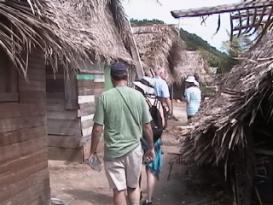
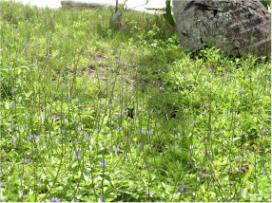
The only schoolhouse for the 13 islands is located here and the children arrive via canoe every morning. They wear uniforms. We visited the Biological Preserve Headquarters and were treated to a coconut to drink by a Garifuna woman.
On
the trek back we saw a field of grasses with green Colibri hummingbirds. The Colibri
is a sacred symbol for the Taino Indians. In the Caribbean the Colibri
is also called Zoom Zoom, Zumbador, Pajaro Mosca and Guacariga. It is greenish
blue in color. The ancient Taino stories call him the Guaracacigaba or Guacariga,
which means the "Rays of the Sun." They say that the Colibris at one
time were flies that were one day converted into little birds by the Sun Father.
It is sacred because the hummingbird is a pollinator and therefore disseminator
of new life. It symbolizes the rebirth of the Taino Indigenous Nation in the
Caribbean.
When we returned to the beach, The Garifuna Dancers arrived by boat from their village at Chachahuate on Lower Monitor Cay, a neighboring island to perform for us on the beach. They danced in a circle one at a time, dragging one foot behind the other in the sand and swinging their hips. This looked very African to me, which of course would be natural, knowing where they originated. The band of drums and maracas provided the music.
The
Italian buffet lunch was served onboard the ship.
After
lunch, Tom spent hours trying to get the hang of windsurfing, but there was no
wind! He kept getting further and further away from shore and finally Stefan
went out in the zodiak and brought him back.
Dinner
tonight is a choice of Prime Rib, Red Mullet, or Yucatan Chicken.
*****
It’s Nautical Night, we’re encouraged to wear blue & white! ****
The
evening entertainment is “Caribbean Magic”, brought to us by the ship’s
carpenter, Kendrik from St. Vincent and the Grenadines. He dances and sings for
us all night, what a talent! Terrific! I can’t say enough about how much I
enjoyed it.
Day
6: Wednesday Feb. 12
Roatan
Island, Honduras
Cruise
ships dock at Port Royal, also known as Coxen’s Hole. We arrived
early to clear Honduras’ immigration. This is the “capital” village of
Roatan. The many stilt houses distinguish this island. This is the commercial
center, much alive with several small shops and an interesting cemetery right at
the port exit. You will find a botanical garden and a bird sanctuary here. Tom
was going on 2 dives here and I did not go ashore at Coxen’s Hole. It was
pouring down rain and we were relocating shortly to Tabyana Beach anyway. I
wanted to enjoy the cruise over and have to catch a cab.
The
island is easy to navigate by car, but please drive the roads in daylight before
you drive them at night. There are several rental car agencies on the island --
including Sandy Bay Rent-A-Car (504-45-1710) and Toyota Rent-A-Car
(504-45-1166). Drivers are required to show a valid drivers license and a cash
or credit card deposit. There are also taxis and buses -- you should always
negotiate the price for a taxi before leaving for your destination. You
can rent four-wheel drive vehicles from Sandy’s, as well. Water taxis
are prevalent in Roatan, shuttling tourists from the West End to West Bay
throughout the day and night.
Discover the unparalleled beauty of Roatan,
the largest of Honduras’ Bay Islands and a Mecca for divers. The eight
islands are collectively known as Las Islas de la Bahia. These islands rest upon
the Bonacca Ridge, the result of an enormous crack which runs long the ocean
floor, about 40 miles northeast of the north coast of Honduras. Lava from the
earth's mantle welled up through this crack and formed the Caribbean plate,
which buckled and created the Bonacca Ridge. Roatan is 40 miles long and less
than 4 miles wide at its widest point. Once
ruled by pirates, then the British and now Honduras, today’s Garifuna
inhabitants are descendants of settlers from Cayman and St. Vincent and speak a
dialect of Creole English as well as Spanish. West End is a tranquil little
village on a magnificent bay with spectacular beaches, all part of a marine and
wildlife preserve that protects much of Roatan from development. Watch for the
rare yellow-naped parrot or learn about marine life at the Institute for Marine
Sciences.
Roatan is an island dedicated to the senses, with palm trees, shimmering sand beaches, and picturesque sunsets. Tabyana Beach ranks up there as one of the prettiest if not the prettiest beaches I have ever seen. Known best for its wonderful sport fishing and incredible scuba diving, Roatan is becoming more popular with tourists with each passing year. The landscape is quite diverse, ranging from dense tropical jungle to vacant white-sand beaches. Roatan is the most developed and modernized island in the Bay Islands chain, and the culture is a mixture of Spanish, British, Paya Indian, and African. The great majority of the citizens on Roatan speak fluent English, making traveling around the island convenient and simple.
The
Paya Indians inhabited Roatan for centuries, until the Spanish raided the island
in the 16th century. Henry Morgan and a band of over 5,000 pirates invaded
Roatan and soon took control. When the slave trade was at its highest,
rebellious British slaves were sent to Roatan. Today the descendants from this
group of people are called “Maroons,” after “marooned slave.” Also known
as Garifuna, they reside near Punta Gorda.
There are a number of splendid outdoor museums on the island, and one of the best is the Roatan Institute for Marine Sciences. Multiple hands-on learning facilities make this scientific complex fascinating. Sherman Arch’s Iguana Farm and The Bird Park are two more great outdoor adventures, and believe me; you will be disappointed if you forget to bring your camera with you to the Iguana Farm! Several of the restaurants on the island are spectacular, and there are quite a few enjoyable clusters of shops and boutiques.
You can purchase a dolphin encounter excursion for $80.00 lasting 2 ½ hours, where snorkelers and divers can swim, dive and interact with a pod of tame bottle-nosed dolphin. The dolphin dive cost is $122.00 for a half a day of diving. Swim with a pod of tame bottle-nosed dolphins in their natural habitat. Get to know these amazingly graceful creatures up close and personal. The excursion includes an informative briefing at the Institute for Marine Sciences and swim time with these highly intelligent, gentle mammals of the sea. From Anthony’s Key resort, it’s just a short boat ride to reach the dolphin area. The dolphins are in a lagoon where you will enter the water up to the waist. Under the supervision of a dolphin behaviorist you are allowed to pet and hug the dolphins. There is a small marine museum on the premises.
Roatan is famous for its big variety of coral, which you can see from only a short boat ride away. A glass bottom boat tour from Tabyana Beach is offered for $24.00 and lasts 1 hour. The coral reef explorer takes you on a voyage of discovery where you see the beautiful formations and colors of one of nature’s greatest wonders in an unspoiled and living reef system. Some of the best-known and most spectacular dive sites are just minutes away. People really raved about this tour and what they were able to see. Maybe I should have done this tour. I did not sign up for any tours here, but decided to just enjoy the beach and snorkel on my own. It was like swimming in a huge aquarium. I have never seen such big and colorful fish anywhere, not on the Great Barrier Reef in Australia, nor at the Ras Muhammed Park off the Sinai Peninsula in Egypt. The reef was just a few feet off the beach. It was incredible.
The islands have many attractions -- brilliant blue and
clear water, palm-fringed beaches cooled by constant trade winds, exotic plants,
and nature trails. One of the finest points about Roatan is the extensive
fringing reef system that offers the most spectacular diving and snorkeling in
the Western Caribbean. Thousand-foot walls festooned with deepwater gorgonians,
coral gardens and barrel sponges, pillar coral, 60-foot deep ledges crowded with
blackcap basslets, mini-walls clustered with bluebell tunicates, pinnacles
overgrown with azure vase sponges, and shy indigo hamlets peering from niches
are all aspects of diving in Roatan. A short boat ride away, you will find
spur/canyon configurations, coral gardens, ledges, overhangs, caverns, and
vertical fissures. Miles of reef leave diving uncrowded and many areas have yet
to be explored by visitors. Large groupers and moray eels are a common sight. On
any given dive, one might see a hawksbill turtle or spotted eagle ray gracefully
gliding by. The reefs are so extensive that it would take months of daily diving
to see each known segment.
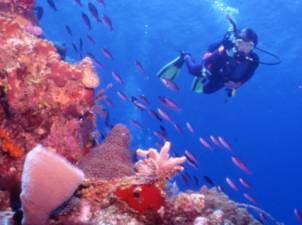
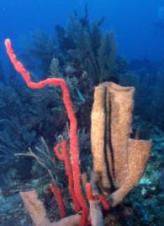
Tom went diving off the wall at the Biological Marine Reserve Park, where they tied up to a buoy and had a great dive down to 71 feet. Roatan offers the ultimate getaway. He was very pleased with all that he saw down there.
I sailed with the ship at 930 AM around the West End and when we had to tack Captain Uli got the passengers involved in pulling on the lines and hoisting changing the position of the sails. We anchored outside the reef at Tabyana Beach and the crew got busy with the lunch being served on the beach today. Whenever Captain Uli decides to say anything, we all eagerly gathered around him. I learned a lot about sailing on this cruise, but nothing compared to what there is to know, of course. He made learning fun.
Surrounded by warm Caribbean waters, this hilly island is as picturesque as it is unspoiled. The warm climate, usually in the '80s, is like the warm greeting you will receive from the friendly inhabitants. The people of Roatan, population of about 30,000, have ancestral origins from eight separate cultures -- English, Spanish, Payan Indians, Garifuna, Afro-Antillean, Anglo-Antillean, Spanish Honduran, and North American. The dress for the entire island is very casual. Comfortable cool clothing, shorts, and lightweight pants are recommended. Even in the evening at better restaurants, the dress remains casual. There are mosquitoes and sand flies, but, if you use repellant, you should not be bothered. Hurricanes are few and far between, and Honduras is generally not in the path of large storms, except for hurricane Mitch a few years back. Windjammer lost the Fantome in that awful storm right here at Roatan Island. Roatan enjoys trade winds the majority of the year, which make the climate even more comfortable.
It was raining a
bit on and off all morning and just as the beach BBQ was ready to go, we got the
last 10 minutes of downpour. Then it got sunny for the rest of the day.
We feasted on
ribs, fresh tuna, spicy chicken, pork, sausage, burgers, salads, corn on the
cob, and all the trimmings. And, I almost forgot, the bar was open: drink now,
pay later!
The reef along
the beach is like a dream for any snorkeller. I just walked a few feet right off
the beach and there is was. Incredible fish were everywhere. The coral too is
incredible; I saw huge brain coral, big purple fan coral, fingers, and
formations I could never have imagined. Tom went diving again in the afternoon
off a different spot along the wall. He was very impressed.
At 5 PM the
captain raised the sails and we sailed off for Belize. The winds are strong and
blowing from the best direction for us. We are at wind power. It’s fabulous. I
love it and the sunset too. This is life. WOW! The bottom square sail is caught
and the captain sends Anatoli up there to loosen it. He is like a monkey in the
rigging. It made for a little extra excitement.
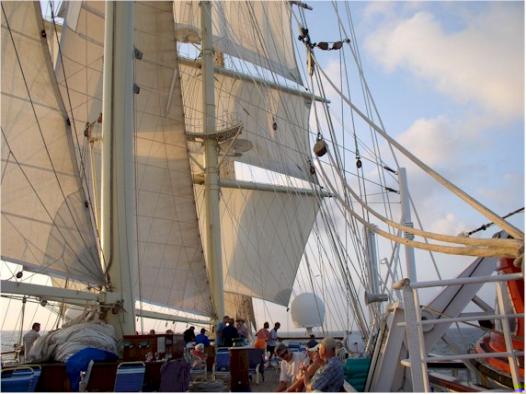
Dinner tonight
is a choice of grouper or breast of duck, not an easy decision as both are
excellent. There was also a great vegetarian zucchini dish. We made many nice
friends at dinner. Tonight our tablemates are a couple from Germany &
Turkey, the East-Coast & England, all of “mixed” nationality marriages
like us. One couple is repeaters and they received a bottle of champagne from
the Star Clippers Cruises that they shared with all of us.
This evening
Mara was playing the True and False games with questions related to the Star
Clipper cruises and the areas that they sail in around the world. She had many
interesting questions, but we surprised her with our knowledge. We skipped the
Karaoke and went to bed as the captain suggested that we rise very early, like
430 AM to see the sunrise and the cruising up the river into Belize City. SURE!
Wannabet?
Day
7: Thursday Feb. 13
Belize
City, Belize
How
would you like to make the acquaintance of a tapir named April? She’s
Belize’ national mascot and extraordinarily friendly – just like almost all
the people you meet in Belize.
We
were still motoring up the river at 6 AM when I first was able to sit up and
look out. By 630 AM we were anchored off Belize City. Located in the heart of
the country, from here you will be able to make your connection to everywhere
else you want to go; from taking a bus to go north and visiting the Community
Baboon Sanctuary, Crooked Tree Wildlife Sanctuary and other attractions to
catching a boat to the Cayes to taking a bus to visit relaxing Placencia, the
adventurous Cockscomb Basin, the only Jaguar Reserve in the world to the
mysterious archaeological sites such as Caracol and Xunantunich and the
interesting Mountain Pine Ridge area.
Cruise ships arrive in Belize
Harbor near the Belize City Swing Bridge. The Belize City Marine Museum in
next door, and this interesting site will give you something to do if you decide
to explore areas close to your ship.
By 730 AM we were on the first shuttle-boat to shore.
This is not a deep-water port, so there is a good chance you will be tendered
ashore. We arrived at the Belize Tourism Village, located on the Belize River
mouth, about 15 minutes away from cruise ship anchorage. Specifically designed
to cater to cruise lines, the Village has courtyards and terminals offering
bathroom facilities, restaurants, snack bars, entertainment (on big cruise ship
days), access to land and marine tours as well as a variety of local souvenirs,
jewelry and clothing stores.
Taxis
can be found everywhere in Belize City, and they are easily recognized because
of their green colored license plates. Taxis are the safest and most reliable
means of transportation. They can transport you anywhere you wish to go within
the city or beyond. The flat rate to travel from any two points within the city
is $3, and $1 for each additional passenger. If you venture outside of Belize
City, you are charged relative to the distance traveled. Cinderella Taxi
(501/24-5240) is one of the best.
Not
only is Belize City your gateway to mystic Maya Sites only found in Central
America, adventurous caves, rivers, unique flora, fauna and relaxing
breathtaking beaches, but it is also filled with history. Belize City has the
only manual swing bridge in the world that is still being swung daily.
The
oldest Anglican Cathedral Church in Central America, St. John's Cathedral, was
built in 1812 from bricks brought as ballast from European sailing ships. Over
the years, Government House (now the House of Culture Museum) was used as an
administrative office and living quarters for the governors of Belize. This was
built in early 1800 with a combination of Caribbean Vernacular and English Urban
architecture.
Our
guide Sidney met us at the Tourism Village and we boarded a bus for a short
sightseeing trip to the Phillips Airport. Here we boarded the Maya Island Air 12
passenger Cessna B208B Caravan airplane for the 45 minutes flight to Flores.
On the way to the airport, Sidney gave us a short history lesson overview of Belize. Belize is marvelously diverse and unique; a traveling adventure like no other. It is perhaps the most ecologically protected and environmentally varied country in the entire world. Featuring the longest barrier reef in the Western Hemisphere, the beaches and keys are fascinating sites to explore. The history of Belize reaches back 4,000 years, when the Mayan empire ruled the land. Around 900 A.D., the Mayan empire began to decline, and during the 16th century, Europeans took over. The cultural mosaic that comprises the mood of Belize comes from influences brought on by the Spanish, Scottish, Garifuna, and British. The citizens, while culturally diverse, remain committed to the land and unified when it comes to preservation of natural resources. Conservation laws protect about 36% of the land in Belize, proving that Belizeans are leading the fight to save Mother Nature. By attending a program sponsored by the Tropical Education Center, you can learn all about the steps being taken to protect the human and natural resources of Belize. The land’s heritage is well known and respected, and the Belizean culture is like no other.
The life in
Belize is truly “un-Belize-able”. Jaguars, mountain cows, and howler monkeys
reside in the rain forests. When expeditions are held, dozens of new bird
species can be found every day. Over 70% of the animal life in Belize is
nocturnal, and, as a result, by venturing on a tour early in the morning, you
can discover an incredible array of creatures. The tropical rain forests remain
unspoiled, and it is home to over 700 kinds of trees and over 500 species of
birds. Wild orchids and many other rare flora are being found all the time, and
this is why it is so important that the land remain protected. These forests
also house herbs and medicines to cure all kinds of ailments, with other
resources no doubt remaining untapped.
The population
of Belize City is just over 200,000, made up of people from Creole, Garifuna,
Mayan, Mestizo, and European descent. All of them live in a state of harmony,
and tourists are treated like neighbors. Locals are almost always eager to
assist you on your travels, and greet you with a kind smile. Belize is also the
only English speaking country in all of Central America, and this is always a
plus with tourists from the United States.
Although,
the Belize Zoo was originally founded as a retirement home for old natural
history "movie stars", the Zoo has become a refuge and rehabilitation
center for injured wildlife, as well as a home for abused and abandoned
"pets". Because there is an abundance of wildlife in Belize, it is
very easy for people to acquire birds and animals that they attempt to
domesticate for their own personal pleasure.
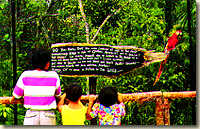 But
when people are unable to tame them, or when they grow tired of their
"pets", the Belize Zoo is always ready to provide a new home for these
orphans.
But
when people are unable to tame them, or when they grow tired of their
"pets", the Belize Zoo is always ready to provide a new home for these
orphans.
Whenever
possible, all wildlife that can be rehabilitated and considered able to survive
naturally are reintroduced to the environment. Those animals that cannot be
reintroduced to their environment are maintained in a natural setting at the
zoo, and they become an integral part of an ongoing program to educate people
about the natural history of Belize.
Want
to improve your natural history experience? Be sure and make the Belize Zoo one
of your first stops. Learn what the indigenous birds and animals of Belize look
like, and how to spot them in their natural habitat.
When you’ve seen the
National Zoo, a world-famous outdoor ecological park, head over to Monkey Bay, a
haven for birdwatchers, or drive to the Mayan ruins of Altun Ha, where tons of
jade carvings have been unearthed, or listen to the riotous whoops of howler
monkeys at the Bermuda Landing Baboon Sanctuary.
Here’s
your chance to experience some of the teeming wildlife and natural beauty of
Belize’s interior. Paddle up the Belize River from Baker's Ranch to the
beautiful village of Burrel Boom. Guides will point out abundant bird life,
iguanas, howler and spider monkeys and the occasional manatee. Look for the rare
and endangered Morelet's Crocodile and enjoy the interesting juxtaposition of
farmland and rainforest along this important river. Listen to the unearthly yowl
of howler monkeys at the Baboon Sanctuary, float down the Belize River and watch
for the Jibaru stork.
The
Maya ruins of Lamanai lies scattered along the lagoon of the New River within
the tropical rainforest of central Belize. Lama'an'ain (submerged crocodile in
Maya) was one of the longest continuously occupied cities—from about 500 BC to
1675 AD or later—probably in part due to its situation on a major trade route,
the New River. Excavated by David M. Pendergast of the Royal Ontario Museum
during a series of field seasons beginning in 1974, its 718 mapped structures
lie stretched out along the shore of the lagoon. Much of Lamanai's importance is
reflected in the large, imposing Late Pre-Classic temple-pyramids, which usually
underlie Early Classic constructions.
A 7 hours tour is offered for $60.00 driving 2 hours each way by air-conditioned coach along the Hummingbird Highway to the Mayan city of Xunantunich. Lunch is included in a typical local restaurant. Passing through several Creole villages along the Belize River and it’s many creeks, you will see diverse cultures from Mennonite farmers in their horse-drawn carts to groups of Mayan, Creole and Mestizo children dressed in colorful uniforms. The drive is dotted with ancient Mayan ruins. You will cross the crystalline Mopan River on a manually operated ferry.
Xunan
Tunich
means stone woman in Maya, and this is how the local people refer to the
site. However, in the reports of old travelers it is generally called Benque
Viejo.
"This ceremonial center is an outlying member of, and on the eastern fringe of, a dense concentration of Maya sites in the eastern part of the Peten district of Guatemala which includes such well-known major sites as Tikal, Uaxactun and Naranjo. After examining the Maya remains in the whole of the Belize river valley, G.R.Willey and others suggested that Xunantunich might in fact have been a fairly important provincial center, perhaps a regional capital.
Whether
this capital of the "Belize valley community" itself owed allegiance
to the much larger sites further west is a matter for conjecture. Certainly the
fine astronomical carved frieze on the main palace building at Xunantunich
should indicate that the priests there were in the main stream of Maya
intellectual culture."

Another
tour is offered to Altun-Ha & biking
for $37.00, lasing 4 ½ hours. This tour is done by a 45 minutes bus ride then
by bicycle over uneven terrain. You must be in good physical condition as this
tour is strenuous. The ruins of Altun Ha are located near Rockstone Pond Village
in the Belize District. As you rumble along the Old Northern Highway, which is
more pothole than pavement, you'll see a few small hamlets with their
inhabitants eager to smile and wave. Flourishing during the Classic Period of
Maya civilization, Altun Ha is located 30 miles north of Belize City and six
miles from the Caribbean Sea. There is no public transportation to these ruins.
Altun
Ha, the
most extensively excavated ruin in Belize, was a major ceremonial center during
the Classic Period, as well as a vital trade center that linked the Caribbean
shores with other Maya centers in the interior. The ruin consists of two main
plazas with some thirteen temple and residential structures.
The
"Jade Head", representing the Sun God, Kinich Ahau, was the most
significant find during Dr. David Pendergast's excavations. At approximately six
inches high and weighing nine and three-quarter pounds, it
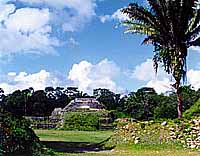 is still to this day the largest carved jade object
in the whole May area. It was found in the tomb of an elderly male priest. Because three of the
seven priestly tombs in the Temple of the Masonry Altars were plundered, having
their contents destroyed and the crypts filled with soil, researchers believe
that the final demise of Altun Ha was perhaps brought about by violent peasant
revolt.
is still to this day the largest carved jade object
in the whole May area. It was found in the tomb of an elderly male priest. Because three of the
seven priestly tombs in the Temple of the Masonry Altars were plundered, having
their contents destroyed and the crypts filled with soil, researchers believe
that the final demise of Altun Ha was perhaps brought about by violent peasant
revolt.
The Jade Head can be seen in the corner of every
Belizean banknote.
The
largest structure on the site is the Temple of the Masonry Altars, which rises
54 ft. A trek to the top of this pyramid is rewarded with a magnificent panorama
of the site and over the treetops of the jungle. This temple went through eight
phases of construction and the round altar at the top is unique to this site. It
was the focus of an unusual sacrificial ceremony in which copal (incense) and
beautiful jade carvings were offered into a blazing fire.
The archaeological site covers about one square mile of area, with at least 500 visible structures and likely had 3000 inhabitants, with a peak population of 8000-10,000 included in the surrounding areas.
Evidence dates
the earliest settlement here to 200 BC, with varied construction phases ending
about 900 AD. Occupation continued after this for approximately 100 years with
re-occupation occurring the 13th and 14th centuries.
There is a trail
running due south from Plaza B that leads you to the main reservoir and onward
through Zone E, a residential area, and several small mounds are visible along
here. Many burials were recovered in this area, providing vast information about
the inhabitants. At the edge of the reservoir is the site of the first temple
built at Altun Ha, dating to the Pre-classic Period (100 AD).
Just outside of
Caye Caulker is the Shark Ray Alley. Sharks and rays are fed by hand regularly,
so they are very friendly. You should note that there is another Shark Ray Alley
in Ambergris Caye.
The
Shark Ray Alley and Ambergris Caye
tour cost $60.00 and last 6 hours. This is one of the most popular snorkeling
sites along the 150-mile barrier reef of Belize.
Another tour offered is the Manatee watch and mangrove corridors lasting 4 hours for $49.00. A water taxi will take you to the mangroves of swallow caye, just a few miles east of Belize City. This is a natural habitat and reserve of the docile and magnificent manatee, nicknamed sea-cow, which is related to the elephant.
For $145.00, divers can join the tour to the Turneffe Atoll. Belize boasts 3 of the four atolls in the western hemisphere and Turneffe Atoll is one of them. Completely surrounded by a living barrier reef, this atoll is a haven for the fisherman, snorkelers and divers. Your 2 tank dive will place you along coral caverns, a coral wall, huge coral formations, and the most diverse sea life you will ever see: from fish to mollusks, from turtle to dolphins. The clarity of the water is something you will never forget; this is diving at its very best.
Goff’s
Cay, Belize
The ship will reposition to Goff’s Cay for the day as soon as every tour has departed the ship. The Belizean government owns Goffs Caye and it is what I consider a small piece of paradise. This little island is so small that you can jog around this island in a minute. The waters are clear, the sands are powder white, and there is an abundance of sea life around the small island, it boggles the mind! Offshore, the longest barrier reef in the New World waits with spectacular diving and snorkeling. Snorkel with friendly stingrays and nurse sharks at Ambergris Cay or check out the bottomless Blue Hole and look for manatees and red-footed boobies at Half Moon Cay.
Tikal,
Guatemala
We decided to take the $330.00 all day tour to Tikal in Guatemala and miss out on all the wonderful diving and tours offered above. Sometimes decisions are hard to make.
The
short flight to Flores was smooth and uneventful. It was partly cloudy, so it
was interesting to observe how the pilot maneuvered through the clouds. Our
group had 3 planes, our 12 passengers Cessna Caravan and 2 smaller 8 passenger
Britten Norman BN2 Aircrafts.
The
trip to Tikal will transport you back to the Pre-Columbian world of the Maya
Empire, when warriors like Great Jaguar Paw and Lord Chocolate battled for
dominance and erected magnificent monuments celebrating their victories. Climb
the steps of the Temple of the Two-Headed Serpent and wonder at the complex city
before you – in the distance you’ll spot the roof combs of un-restored
temples, still wrapped in jungle vines.
Miguel
Ángel Asturias, named Nobel Laureate in 1967, wrote, "Only Guatemala is
comparable to itself," describing it as "a land of natural
dreamscapes...mysterious presences and absences." Tikal, the largest known
Mayan city, is incomparable in the same way; its size imposing and intimidating,
its setting lush and teeming with wildlife, and with a mysterious and
overwhelming atmosphere best described in the writing of Asturias:
"The imagination reels. There are reliefs, pyramids, and temples in the extinguished city. The damp murmur of the arroyos, voices, crepitations of the intertangling vines, the sound of flapping wings, trickle into the immense sea of silence. Everything palpitates, breathes, exhausting itself in green above the vast roof of Peten."
We landed at Peten Airport in Flores and Carlos met us here. We cleared immigration and boarded the bus for the one-hour ride to Tikal. Carlos was full of information and knowledge. His enthusiasm was catching. It was obvious that he loves his country and to tell tourists about it. Hector, the driver was a bit scary, however. It was difficult to believe sometimes that he had any experience at all driving a big bus.
Carlos told us that the city of Tikal was the largest of the ancient Maya cities in Mesoamerica. It was located in the Yucatan in the modern day country of Guatemala. During the Mayan Era in Mesoamerica, Tikal reached its peak population of approximately 55,000 people around AD 700. The city itself contained many different structures inside its boundaries. These structures included numerous resident areas, temples, pyramids, shrines, ball courts and ceremonial structures. All of these things existed within the boundary of Tikal, which was about 60 square miles. The most impressive of the structures at Tikal are the temples. The most important of these temples is the Temple of the Giant, Temple I, which stands 212 feet high. This temple is the largest building in the ancient Mayan world.
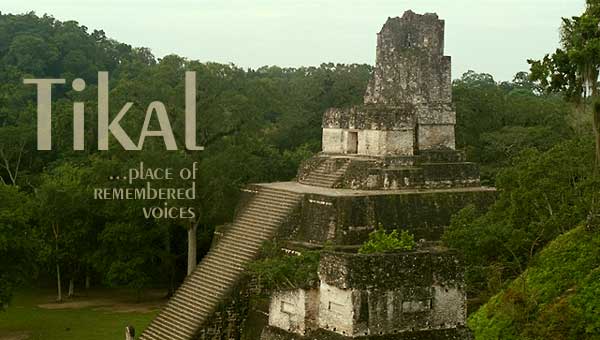
There
are many other temples in Tikal, but none as impressive as this great Giant. The
presence of the North Acropolis is also noticeable. This is because they
surround the area of the Great Plaza. The plaza is where most of the people of
Tikal went to socialize. There is another set of Acropolis called the Central,
which overlooks the Eastern Court Palace in the Eastern section of Tikal.
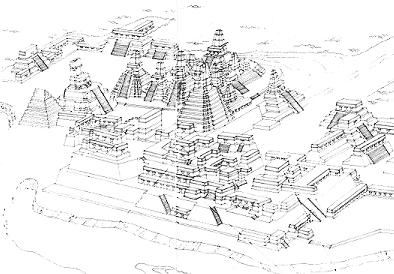
Tikal
had many rulers throughout time who had monuments constructed after them. There
were 14 different rulers between 320 AD through 869 AD, to have a structure
built or named after himself.
Tikal
was so called "discovered" in the late 1800’s by archaeologists who
followed rubber trappers through the forest. This is the first time any European
had seen the ruins of the once great Mayan civilization. There is evidence at
Tikal that supports the theory that warfare led to the collapse of the Maya in
the 9th century. This warfare is said to have caused the collapse of Tikal and
the surrounding environment.
After
we got off the bus and entered the area, Carlos took us on a jungle walk to the
Twin Temples. We walked on uneven ground and there is a lot of walking, which
can be difficult for some people. First we stopped at the national tree of
Guatemala, the Ceiba tree. This tree is huge and has many air plants growing on
it. This does not hurt the Ceiba tree, on the contrary. When there is a drought,
these plants store water for the tree to keep it alive. All of a sudden there is
a family of spider monkeys jumping from treetop to treetop above us. How
exciting! A mother is carrying her baby on her back. We head for Temple IV, the
tallest Maya Temple. It’s not safe to climb the stairs, so wooden steps have
been constructed to the top at the back of the temple. The view from up here is
magnificent. I see jungle, jungle all around and here and there the tops of
nearby temples above the canopy.
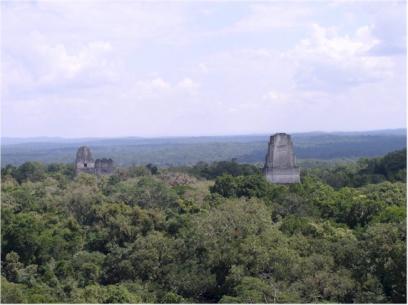
An ancient Mayan pyramid looms out of the steaming jungle. Howler monkeys screech in the trees as you climb crumbling steps to an altar where human blood was once shed to appease the gods. The stylized figures of jaguars and serpents and birds carved in stone eons ago tell you that the people of this forgotten realm lived amidst some of the most exotic flora and fauna in the world.
We walk next to the main square, the Acropolis. The most interesting things to me are the masks of stone in the face of the temples. Here we have free time to roam and explore on our own. There is so much to see.
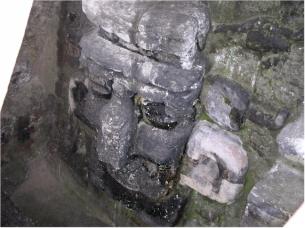
Lunch
is included in the tour at a restaurant inside the park. The spicy grilled
chicken is delicious. Soon a couple of Coatimundi are trying to steal
from the guests and are chased away. They soon come back. The Coatimundi, also
known as the White-nosed Coati, is diurnal, living both on the ground and in the
trees. This member of the racoon family is omnivorous, feeding on fruits,
invertebrates, and other small animals. They feed by using their long noses,
poking them under rocks and into crevices, and using their long claws to dig
holes or tear apart rotting logs. The coati often is seen in large groups of up
to 30 individuals. When surprised, the entire group will leap into the trees
while emitting clicking and explosive "woofs" type of sounds. During
the night, coatis sleep in the treetops in nest of leaves and branches.
Coatimundis
range all through Central America and are found throughout Belize, from the
mangrove forests of the coasts, the savannas of the lowlands, the dense tropical
forest of the interior. Locally in Belize, the coati is known as
"quash".
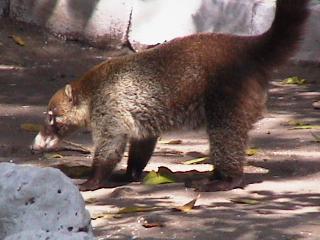
After
lunch we have to make our way to the exit and the bus for the trip back to the
airport. We have no time to shop any of the colorful market stands here. Oh
well!
We
had all come prepared for the super mosquitoes that are supposed to be eating
tourists alive at Tikal. I did not encounter a single one. They are really thick
in the summer, Carlos said, especially in August and September when the park is
flooded with European tourist on summer vacation. Then the mosquitoes follow the
tourists around like black clouds, they can’t even stop to take a picture
without getting attacked.
Hector is till driving crazy, but we make it back to Flores OK. The horses are starving in the fields along the road. I can see their ribs showing under the skin. We said goodbye to Carlos. He was a good guide. We have to pay $30.00 departure tax in US cash to leave Guatemala per person. I wonder where this money goes? This time Tom & I ride in one of the smaller planes.
All of a sudden next to a lake I see a Mayan temple sticking up above the jungle canopy. From above it looks totally impossible to penetrate the jungle and visit the site. I learn later it is Yaxha in Guatemala, but very close to the border. It was supposedly the third-largest city in the Mayan empire, a bustling trade and ceremonial hub 20 miles from Tikal, one of the greatest centers of Mayan culture.
What
a difference a millennium makes. Today, Yaxha is an obscure cluster of oddly
shaped hills covered with vines and towering trees. Troops of howler monkeys
scramble through the treetops, fighting for space near the lake. The only sign
that it was once a great center is a single weathered gray pyramid, the earth
stripped from most of its side.
Like
hundreds of other Mayan cities, Yaxha remains largely unrestored and neglected,
moldering away in the vicious heat and soaking rains of Guatemala's vast
northern territory called the Petén.
It
is difficult to imagine a newly discovered pyramid in Egypt sitting untouched
and unexplored. Yet that is what happens with thousands of Mayan sites
throughout Central America.
"We
simply do not have the resources to investigate them all," said Luis
Fernando Paniaqua, head of the government's Department for the Registration of
Cultural Property, which tracks Mayan artifacts. By some estimates, there are
more than 2,000 Mayan sites in Guatemala alone, only one in 20 of which actually
have guards posted at them. One of the problems is that such sites are difficult
to reach. Yaxha, for instance, is at the end of a long and dusty three-mile road
where tourists have occasionally been pulled from their cars and robbed. There
is a lodge nearby, but little else in the way of creature comforts.
Belize
is a contrast to Guatemala like the US is to Mexico. You know when you cross the
border. All of a sudden big farms are visible that are well maintained, neat and
orderly. Guatemala is full of slash and burnt farms with no visible order. There
is still plenty of pure jungle in both countries.
The
flight is smooth and uneventful. As the Star Clipper is now anchored off
Goff’s Cay, a tiny beautiful island with some palm trees and nice white sandy
beach, we have a one-hour water taxi ride to the ship from the Tourist Village.
A great bright red sunset is a real treat for us tonight. The Star Clipper is so
beautiful with her lights on. We feel at home on her now. I feel like in a
dream.
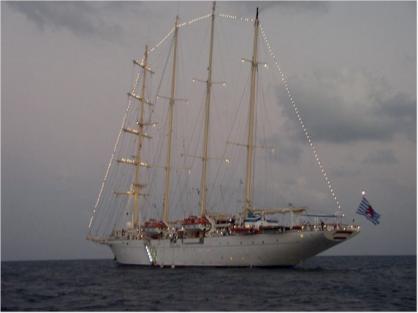
Dinner tonight is swordfish, veal cutlet or my choice is the light dish tonight of shrimp, mussels and calamari on a bed of rice and veggies. The theme tonight is Pirate’s wear. Some people are dressed to play the pirate games on the Tropical Deck tonight.
Day
8: Friday Feb. 14
Majahual,
Mexico
The
tiny fishing village of Mahahual is located on Mexico's Southern Caribbean, 140
km from Chetumal in the
southern most part of the state of Quintana Roo. Known as the Mayan coast, in
Spanish Costa Maya, the town of
Mahahual is at the geographic center of the coast. The Costa Maya takes its name
from the many centuries over which the Mayan people have known of this fishing
and diving paradise. Its
beach has white sand and blue clean waters making Majahual the ideal place for
swimming and fishing. The fishing village of Xcalak, where you can rent a boat
to visit Banco Chinchorro,
is located 50 kilometers south of Majahual.
Having
slumbered for hundreds of years, Majahual is now beginning to awaken to the
attraction of eco-tourism. Since it is located just south of the huge 1,500,000
acres Sian Ka'an wildlife preserve, Mahahual has recently been discovered by
tourists from North America. Because of it's tropical location, latitude 18
degrees, 40 minutes north, or only 1,120 miles north of the equator, Mahahual's
crystalline clear waters are always warm. Here divers can discover countless
beautiful coral formations, sponges, sea turtles, dolphins, sea horses,
manatees, and thousands of sport and reef fish.
There are several small restaurants on the beach in
Mahahual where delicious lobster and fresh fish are served daily. There are also
several small hotels with rooms to rent that cater to divers, tourists, and
fishermen. The pace of life in Mahahual is still slow and it takes people a few
days to become accustomed to the relaxed tropical ambience.
As the Caribbean's newest cruise ship destination, Mahahual is now home to a new cruise ship dock and mall. A new power station and water plant were recently completed. New roads and electrical lines are now being installed on Costa Maya both north and south of Mahahual. Costa Maya, or Puerto Costa Maya opened in 2001 and is located in the southeastern-most part of the Yucatan Peninsula on the Caribbean Sea at Majahual (Mahahual) just north of the Belize border. It has a small beach and a dozen shops but is rapidly developing. The Costa Maya cruise ship pier is located approximately three miles to the north of the town. An elaborate fresh-water pool has been constructed near the passenger pier and local entertainment is presented at a poolside stage. The Chinchorro Reef, about 30 miles long and 9 miles wide, is situated 20 miles to the east and is a favorite snorkeling and scuba destination.
This port is exposed to the open sea and is subject to heavy winds and strong currents, making it difficult at times to land at the pier. This is what happened to us. Due to currents and heavy winds, we could not make the stop at Majahual today. Captain Uli wisely decided not to chance smashing the Star Clipper against the pier. We got another full day of sailing instead. This was much to my delight. We had another great day of sailing on the beautiful Star Clipper. Only people who were going to make the excursion to Kohunlich were disappointed as this was the only planned trip to a Maya ruin for some of them.
We
had signed up for the Outdoor Bike and Kayak
Adventure excursion tour offered for $32.00 and lasting 3 hours.
It’s an experience first hand of the endless stretches of beach and local
flavor as you ride and kayak the coast. The guide meets you at the pier with the
bikes, helmets, pads and gloves. Riding south along a dirt road, you pass a
small mangrove lagoon and breathtaking views of the coastline on the way to
Majahual. After a leisurely ride passing traditional houses and restaurants, you
arrive at the beach where the kayaks are waiting to let you set out to sea in
the crystal blue waters of the Caribbean. Pass along a nearby reef; enjoy the
views and the golden sun. You will be taking a different route back with the
bikes.

Another
tour is offered by air-conditioned bus to the Kohunlinch
Mayan Ruins for $97.00, lasting 8 hours. These ruins are located
close to the Belize border. The drive is 2 hours each way and lunch is included
in a local restaurant. This tour involves considerable climbing and walking on
uneven surfaces.
Kohunlich
is a corruption of the name "Cohune Ridge". Cohune is a species of
fruiting palm common to the area. Kohunlich used to be known as Clarksville,
which is how it is referred to in old maps and reports.
The
site is best known for its Temple of the Masks, an Early Classic pyramid whose
central stairway is flanked by huge humanized stucco masks. Built around 500
A.D., this is one of the oldest constructions at the site. After 700 A.D., this
temple was covered over with a Terminal Classic construction, which protected
the masks and accounts for the marvelous state of their preservation today. The
only standing remains of the later temple are some steps in the lower portion of
the stair.
We
sailed leisurely on to Cozumel, taking advantage of the prevailing winds. We had
the time now to enjoy the ship. I was pleased, since I came on this trip to sail
on this beautiful barquentine ship. Captain Uli gathered a crowd for his talk
again. We got a lesson on the history and voyages of the Clipper ships. He
pulled out a personal copy of an old movie “Around Cape Horn” by Irving
Johnson from his 1929 voyage on the Peking. It was narrated in 1980 by Irving
Johnson himself and lasts for 45 minutes. It’s available from Mystic Seaport
Museum. Mara would be showing it on the in-cabin TV after lunch BBQ served on
the Tropical Deck.
It’s
fairly rough seas today with high swells and the Star Clipper rides the waves
very nicely. I’m wearing my Seabands, so I enjoy it. I’m surprised at how
steady she rides and how smoothly she takes the waves. It’s no worse than a
similarly rough day we had on the Zuiderdam or the Crystal Harmony between Aruba
and the Panama Canal and she is 50,000 ton. I think that is remarkable. About
100 Bottlenosed dolphins enjoy showing off for us, jumping and frolicking around
the ship for about 45 minutes.
Tonight
is Captain’s night and we get a choice of lobster or tenderloin. After dinner,
everyone seems to get involved with the crew and perform in the Talent Show.
What a great cruise! Such a talented crew!
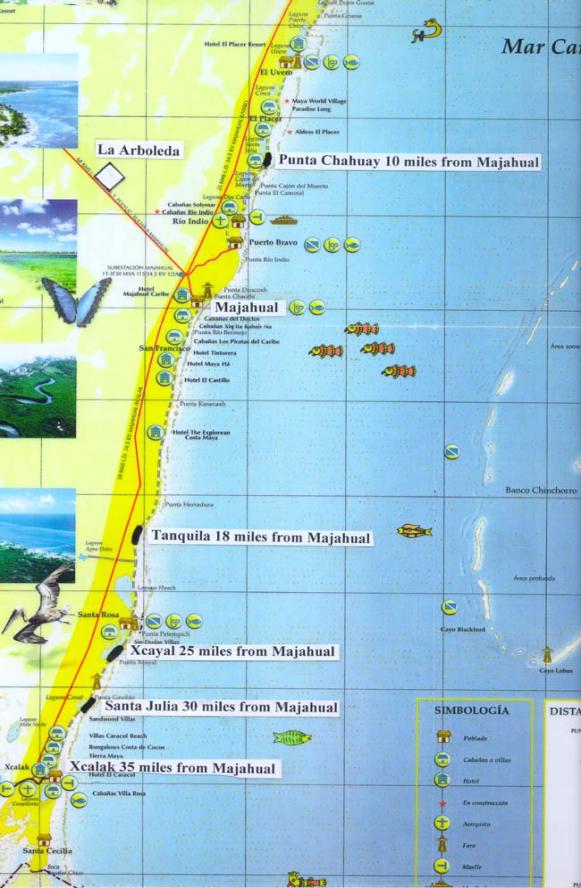
|
Mexico's Costa
Maya is the Last Frontier, where the sounds of nature surround you, and it
is not unusual to sight a wide variety of wildlife typical of the region,
which includes over 108 different species. It is not uncommon to see
turtle nests, ocelots, monkeys, toucans, and other species you'll be
discovering for the first time. With a mysterious air that surrounds it,
the jungle is an enchantress that beckons you to explore it. With the
government having major development plans in mind, Costa Maya promises to
become the next important tourist destination in the Caribbean.
Development in the Costa Maya has just started to bloom. |
|
|
|
The Costa Maya
is the place to forget about tension and stress, a place to lay back on
your hammock under majestic palm trees, sipping a cool drink, watching
schools of silver fish jump out of the sea and soar the surface. Life is
quiet and simple here, with just enough hotels and restaurants to receive
those tourists that arrive looking for adventure and a close encounter
with nature. The Costa Maya is intertwined with the routes of the Mundo Maya, its natural forests keep the Maya's secrets, you could be the one to discover a hidden ruin, lost in the ages of time, surrounded by a quiet energy of its own, a mysterious silence disrupted only by the birds calling out to each other, or an occasional monkey screaming out its annoyance for disrupting his peace. Not far from this hidden paradise on Earth is the beautiful lagoon of 7 colors in Bacalar, famous for being witness to fights among pirates, Spaniards, and Mayans centuries ago. The Bacalar Lagoon is a body of fresh water, whose breathtaking seven colors and sandy bottom is a stunning replica of the Caribbean Sea. |
|
A central part
of this place's beauty is Banco Chinchorro, a natural wonder renown all
over the world by diving lovers and those that do sport fishing. This is a
coral reef bank with over 65 species of marine flora and more than 262
different varieties of animal life. It is a vast, wonderful water world of
unexplored treasures, where hundreds of years of hidden secrets lie yet
undiscovered. Spanish ships have lain in the sea floor for centuries, with
untold stories of pirates and treasures within their flooded insides. Now,
they are home to beautiful, majestic sea creatures, like the eagle ray,
which appears to glide the seawater with an effortless and lithe grace. |
|
|
|
Day 9: Saturday Feb. 15 Cozumel,
Mexico Cozumel
is renowned as one of the greatest diving destinations in the world. The
Palancar Reef is on the must-see list for any dedicated diver. If
you don’t want to get wet, you can explore the underwater world of
Chankanaab Lagoon in a submarine, or wander flower-filled pathways of the
lush botanical gardens above. You
can take advantage of the Caribbean waters by swimming or trying other
water sports like windsurfing and parasailing. |
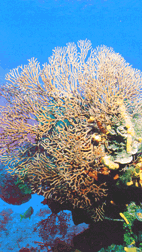
Cozumel is Mexico's largest island, nestled just 12
miles off the coast of the Yucatan Peninsula. Cozumel measures 30 miles long
& 9 miles wide, and is world renown for its dazzling white sandy beaches and
the remarkable clarity of the multi-hued azure Caribbean ocean in which it
rests. The climate is subtropical & the people native to Cozumel are of
Mayan descent.
Set in the midst of the brilliant emerald waters of the Caribbean, Cozumel has a colorful, romantic past. Dazzling visitors since it was "discovered" by Juan de Grijalva in 1518, this island has been home to Mayan pilgrims who left mysterious temples, French pirates who left sunken galleons and visiting American soldiers who built the San Miguel airport. The combination of spectacular coral reefs, located just off the southwestern coast, and the exceptional clarity of the water has made the island a diver's haven. The natural beauty and tropical serenity of Cozumel will appeal to everyone.
There
are two very different kinds of beaches on Cozumel. On the west coast of the
island facing the Mexican mainland you'll find stretches of golden sand, often
with all the amenities of a beach club. On the east side facing the Caribbean
Sea, quiet beaches alternate with rocky shores along the vast expanses of this
solitary coast. Waters on the more populated west side are generally calm, while
the roaring surf on the east creates slightly rougher conditions. Tennis and
horseback riding are also popular outdoor
activities on
the island.
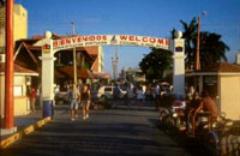
Everyone
has to show up in front of the Mexican immigration officers this morning with
their passport to clear entry into Mexico. This is done in the library. As soon
as this is done, we can go ashore. The Star Clipper is at the Punta Langosta
pier in downtown San Miguel de Cozumel. The ferry from Playa del Carmen comes in
at the Town Pier, which is only a 3 minutes walk from Punta Langosta
pier.
The
big cruise ships dock at either the International Pier, located south of
town near the La Ceiba Hotel, or the new Puerto Maya Pier, which is a bit
farther south on the Island. It will take about 30 minutes to walk into town
from there.
There
are 4 big ships in there today, 3 ships are from the Carnival Cruise Line and 1
from Royal Caribbean Cruise Line. Taxis can take you directly to San Miguel, the
main city on the island, for approximately $5-10.00. The developed areas of
Cozumel are fairly centralized; therefore, walking is the preferred way to get
around the town.
However
there are a couple other options if you would like to explore the more remote
beaches and sites.
Taxis:
From San Miguel to the southern tip of the island, the average taxi fare will be
$10.00. You can arrange for a driving tour of the entire island for
approximately $60. Taxis are readily available.
Mopeds:
If you'd like to add another dimension to your vacation, a tour of the island by
moped can easily be accomplished, with a stop at the island's most impressive
ruins. Moped rental agencies are extensive in Cozumel and cost approximately $30
for 24 hours. I saw these rental agencies everywhere. Be sure to read all the
fine print before renting a moped in Cozumel. You may or may not be insured for
damage and theft of the bike. In addition, be aware that helmets, by law, must
be worn at all times.
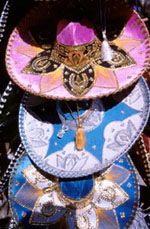 If you’re looking for a beautiful Caribbean style
vacation within Mexico, then look no further than Cozumel. This lovely hideaway
is Mexico’s largest island, yet remains somewhat undiscovered by Mexico’s 20
million annual visitors. Yet only 3 percent of its land has been developed,
making it an ideal place to explore the region in its pristine and nearly
unaltered state.
If you’re looking for a beautiful Caribbean style
vacation within Mexico, then look no further than Cozumel. This lovely hideaway
is Mexico’s largest island, yet remains somewhat undiscovered by Mexico’s 20
million annual visitors. Yet only 3 percent of its land has been developed,
making it an ideal place to explore the region in its pristine and nearly
unaltered state.
Cozumel’s
history is centered on its importance to the Mayan culture as one of three
ceremonial centers in the region, and this link to the past can be further
explored by paying a visit to one of 40 archeological sites still present on the
island. When the Spanish took over the island in 1519, Cozumel became a pivotal
trading center in salt and honey. The collapse of the Spanish Empire in the late
16th century ushered in nearly 300 years of obscurity to this
Caribbean land, yet it has recently flourished as a popular cruise and travel
destination; luring people from across the globe to bask in its wonderful
weather, amazing diving locations, and friendly people.
Cozumel, although not nearly as developed as its northern neighbor Cancun, still contains all the resources necessary for the ultimate cruise destination. Shopping is prevalent, and duty-free stores, selling everything under the tropical sun, invite the seasoned bargain hunter. I explored the shops and walked around the main street, Avenida Rafael Melgar and plazas, the Zocalo. It was early in the day and the stores were not crowded. But after an hour all the jewelry stores looked the same to me as they were offering the same stuff. I headed back to the ship. The sidewalk along the Avenida is a bit narrow on the sea side, but I enjoyed looking at the gorgeous colors of the crystal clear waters, which range from stunning turquoise to deep indigo.
I watched as the RCCL ship was coming in from the open sea. It is a stately sight. I love watching the ships and guessing which one it is.
Tom went diving at the famous Palancar Reef with its caves and canyons, plentiful fish and wide variety of sea coral. Palancar Reef is the island’s most famous reef. Renowned the world over for its three-dimensionality, Palancar sits on the crest of a wall. It is consists of a series of huge pinnacles separated by large, deep channels. Sponges and corals blanket the area. Palancar is also one of the islands largest reef systems so many return visits are not likely to cover the entire area.
After a seafood buffet lunch he went to Paraiso Reef. Here reef systems run parallel to shore interspersed with sand channels. Large coral heads and sponges make a good habitat for lots of tropical fish. South Paraiso Reef consists of two coral mounds that stretch parallel to shore.
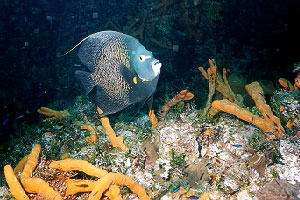
Cozumel
is the number one dive destination in the Western Hemisphere and has been
consistently rated the best spot in the world for
scuba diving and snorkeling. The Great Mesoamerican Reef System
stretches for more than 1,000 km (620 miles) down the eastern coast of Yucatan
to Belize, Guatemala and Honduras. There are diving sites on the reefs to suit
every ability level. The best known places can be found off the island of
Cozumel. Most diving done in Cozumel is drift diving. This often entails having
a charter dive boat drop you into the water and follow your progress, picking
you up at the end of you dive.
Cozumel itself was a sleepy little fishing community until 1961, when a Frenchman by the name of Jacques Cousteau declared us one of the most beautiful scuba diving areas of the world. Since that time Cozumel has become an underwater marine park to protect the delicate balance of its dazzling coral reefs & abundant variety of tropical fish. The underwater wildlife is absolutely amazing here & due to the clarity of the water, 100 - 200 ft visibility, depending on the season, you do not have to be a diver to enjoy it. Simply put on a mask & snorkel and jump in & you will feel like you have been dropped into a tropical fish tank !!
In addition to the spectacular open water diving, the region of Cozumel and Akumal are well known for the underground rivers that honeycomb the porous limestone of the Yucatan which provide some of the most beautiful cave and cavern or "cenote" diving in the world. Many of these caves are very highly decorated and are like floating through the finest dry cave you have ever seen, simply filled with water that is as clear as air. Because they are supported and protected by their water filled environment, they are pristine and each has its own particular marine life, unique to a cave environment.
Cozumel is a quiet little island, with many great restaurants in which to enjoy wonderfully fresh seafood and local specialties. The restaurants on the island are world-class as well as affordable. Its proximity to the popular excursions of Xel-Ha Lagoons, the Mayan ruins at Tulum, and Playa del Carmen solidify its position as one of the top cruise destinations in the Caribbean. Cozumel also boasts an exciting nightlife, so there really is something for everyone!
I decided to take the Swim and snorkel with Dolphins excursion, which is offered her for $122.00 and lasting 2 hours. This unique adventure is one of a kind exclusive experience designed to meet the needs of all wrapped into one, in a safe, clean and friendly environment. This will be an ultimate close encounter with a dolphin, so I couldn’t resist.
Dolphin Discovery Cozumel is located in Chankanaab National Marine Park. We were met at the ship by a park representative after lunch and transported via taxi to the park. We were given instructions of what to expect and how to behave with the dolphin before being allowed in the water with them. We are divided into small groups of 8 persons and assigned 2 guides and a dolphin. Picasso comes to us from Cuba. He seems so gentle and friendly, as if he really loves the interaction too. First we enter the water onto a platform where we stand and Picasso swims by to be touched, cradled, hugged and kissed by everyone. Then we swim out one at a time to one of the guides, who instructs Picasso to turn over on his back and swims under us and lets us grab his pectoral fins and then returns us to the platform. This was incredibly exciting for me. I’m not that comfortable in deep water, but this was one of the most memorable experiences in my life. I felt like a child again.
Then one of the guides dons his scuba gear and walks on the bottom of the sea and “controls” Picasso while the other guide stays on the surface with us as we snorkel around with Picasso swimming around us weaving in and out between us letting us touch and pet him. He never bumped anyone. We spend about an hour with him altogether. The dolphins all show off their jumping ability and can wave goodbye etc. I really enjoyed this excursion.
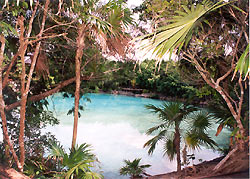
Chankanaab Lagoon
We could stay at the park as long as we wanted and
everyone was given a taxi voucher to get back to the ship at our own leisure.
The park closed at 4 PM, so I didn’t get to see everything and I will
definitely return to see the rest of the park. This is a place you would come to
spend the entire day. Here is what
there is to do: Chankanaab is just 9 km
south of San Miguel and offers diverse attractions in a lovely setting. The main
beach is studded with palapas for sunbathers, while just off shore there's
outstanding diving and snorkeling. Back from shore is a fascinating
Archaeological Park, complete with winding jungle trails, replicas from sites
throughout Mexico, a typical Mayan village and free, guided tours. There's also
an excellent Botanical Garden with over 300 plant species from 22 countries.
Topping things off is the site's beautiful lagoon - a sinkhole filled from the
sea by underground tunnels. There are several shops, snack bars, a restaurant,
and a Mayan Museum. As well as offering world class diving and
snorkeling, this beautiful park houses a sea lion show, and the tropical lagoon
is teeming with brightly colored tropical fish. Open
Daily. Admission is $10 (US) and children are free.
I priced the swim & snorkel dolphin encounter at $90.00 if purchased at the park. There is a 2 dorsal swim program offered as well where you get 2 dolphins and also get a ride on their noses with one foot on each. It sells at the park for $120.00. The taxi ride is $10.00 each way and the entrance is $10.00, so I don’t feel that I overpaid for this tour at all.
Another tour offered is the Atlantis XII submarine tour that sells for $98.00 and lasts 2 hours with transfers. The 48-passenger submarine, Atlantis XII, offers you a chance to experience why Cozumel remains one of the top dive destinations in the world. Diving to depths of up to 100 feet, Atlantis brings you up close and personal with Cozumel's top attraction, Chankanaab, an exciting part of the second largest reef in the world. Chankanaab, an underwater marine park established to protect the delicate balance of its dazzling coral reefs and countless species of tropical fish, offers crystal clear visibility of up to 200 feet.
An all day tour to the ruins at Chichen
Izta by
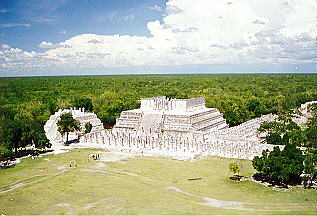 Air
was also offered for $190.00 plus tax ($35.00).
Air
was also offered for $190.00 plus tax ($35.00).
Chichen - Itza,
world famous archaeological zone, is located 120 km from Merida
via federal highway 180 in the State of Yucatan
Mexico. The name Chichen - Itza is derived from the Mayan language:
"Chi" - mouth, "Chen" - well and "Itza" - the
tribe that inhabited the area.
Chichen - Itza is the most visited
archaeological site in the peninsula of Yucatan,
due to its extraordinary architecture, beauty and its geographical location. The
priest LAKIN CHAN who was also called Itzamna founded it in the year 514 of our
era. This is why their people were called chanes or itzaes.
When the Spaniards arrived to Chichen -
Itza, it had been abandoned as a consequence of the civil war fought with
Mayapan. In between 1196 and 1441 the final collapse of this culture took place
in the north of the peninsula. The conquerors found the buildings partially in
ruins and their names and real use were unknown; this is why the present names
are suppositions.
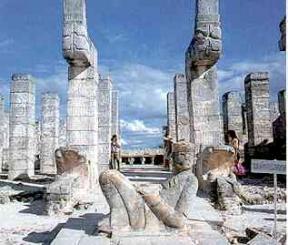
The archaeological site is divided into 3
areas: the Northern group (distinctly Toltec), the Central group (early period)
and the Southern area known as the Old Chichen (located far away from the other
buildings and its visit requires a guide).
NORTHERN GROUP:
The Pyramid
of Kukulcan (also known as The Castle) where
both theology and astronomy, combine to produce a unique spectacle twice a year,
the Spring Equinox and the Autumn Solstice, days when the shadows projected over
the architectonic elements of the building resemble a serpent descending to the
ground. Inside the pyramid are located the famous Chac Mool sculpture and the
Jaguar Throne.
The Marketplace
The Steam Bath
Temple of the Warriors
Platform of Venus
or of the Dance
Sacred Well
or the
Well of the Sacrifices
Tzompantli,
that displays figures of skulls
in
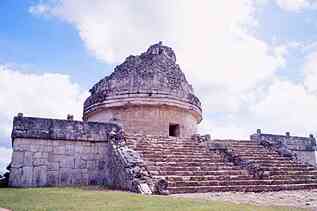 relief
relief
Platform of Eagles and Jaguars
The Ball Court and the Temple of the
Jaguars
CENTRAL GROUP:
The Ossuary
The Red House or Chichan Chob
The House of the Deer
The Caracol or Observatory
The Nunnery
The Church
The Akab Dzib
Temple of the Carved Panels
The Well of Xtoloc
The Temple of the Bearded Man
The three areas can be seen comfortably
in one day. Also you should enjoy the wonderful Light and Sound Show that is
held every evening.
Chichen
Itza is the most impressive and intact ruins of Mayan civilization that the
modern world has. This now popular tourist attraction is located on the Yucatan
Peninsula of Mexico and has fast become the best-restored record of the
spiritual, domestic, and agricultural lives of these people. Mayan ruins in
Central America, such as Chichen Itza, are remnants of cities that were
abandoned long before Columbus reached the area; yet this culture has influenced
many areas of architecture, art, and astronomy that live on even in our modern
world.
The Mayan people are most famous for their brilliant and advanced astronomical knowledge and their resiliency. Stone remnants of their civilization are currently being preserved at various sites in Mexico; in Tilkal, Guatemala; in Altun Ha, Belize; and in Copan, Honduras. Mayan civilization spread from their origin on the Yucatan Peninsula to the rain forests of Mexico eastward and the other surrounding countries. Today, mostly on the Yucatan Peninsula and in the state of Chiapas, Mayan culture is still thriving with four to six million people, over 30 languages, and many ethnic backgrounds represented. Modern Mayans still continue many of the traditions of their ancient culture, such as speaking their ancient dialects instead of Spanish, growing their traditional crops (corn, beans, chili, tomatoes, and squash) with the same techniques, and using herbal medicinal treatments instead of modern medicine. Many spiritual aspects of Mayan life, the purpose for their ancient cities, are still exercised with many offerings and pilgrimages to modern churches, sometimes fusing Catholicism with Mayan beliefs from antiquity.
A 4*4 Tropical Jeep Safari Tour is offered for $67.00 lasting 4 hours.
It’s our last night and it’s not very far to Playa del Carmen. We will sail at midnight. Dinner tonight is Surf and Turf for me, or baked chicken or Veal Marsala. The food choices have been exceptional on this cruise. I have not heard any complaints about the food, the service or the size of the portions. Everyone seems very pleased with everything.
The captain has to announce a change of plans. The winds are strong, blowing at 30 knots and are not expected to subside, therefore he has to decide on the advise from the Harbor Master at Playa del Carmen that we will remain in Cozumel overnight and disembark in the morning and take the ferry across to Playa. It would be impossible to anchor off the reef at Playa and unload all the passengers onto the tenders with the luggage too as the ship and the tenders try to connect. No way! It’s been windy all day today, but the western side of Cozumel is in the calm area. Playa is not. Some people are grumbling about this, questioning the “real” reason! What for? Another adventure awaits, that’s how I look at it. The crew will transfer the luggage and we pick it up at the pier in Playa as scheduled. The only inconvenience is that we have to leave much earlier to go on the scheduled tour to Tulum. Big deal!
Before packing, Tom and I take an evening stroll along the Avenida after dinner in the warm Mexican night. This is heaven, as we rarely have wonderfully warm evenings like this in Seattle, not even in summer.
Day 10: Sunday Feb.
16
Playa
del Carmen, Mexico
We
had come for something beyond sightseeing and gourmet meals. We had come to feel
the teak deck heave under our bare feet, to hear the creaks and moans of the
Star Clipper as she soared before the wind, to revel in the vastness of the sky.
Some of us joined deck hands hauling up a sail or two so we could say we helped
sail a real, live clipper ship. Others simply craned their necks in awe like me.
Almost everyone appeared on deck whenever the captain would speak or that
stirring sail-hoisting music seduced us back to the glory days of the great
clipper ships. I didn’t want to leave. I wasn’t long enough. I’ll be back,
…. Soon.
The
ship arranged for taxi transfers to the Town Pier, even though it was not a long
walk. We are on the 7 AM ferry for the 50 minutes ride across to Playa. It seems
calm on the seas until we get there. Amazingly, the waves come crashing in all
of a sudden. It is rough today at Playa and Captain Uli made the correct
decision in my opinion.
The half-day tour to Tulum sells for $50.00. We leave from the ship with the luggage in the coach. The tour ends at the Cancun airport or at our hotel. This is perfect for us. A cab from Playa del Carmen to Cancun or the airport runs $50.00. This way we get to see Tulum too. What a deal!
Tulum
Cancun’s reputation as a
magnet for sun-worshipping celebrities and glittering nightlife is
well-deserved, but a few miles from Star Clipper’s pier in Playa del Carmen,
there are quieter, but no less spectacular sights. The ruins at Tulum are the
only place where the Maya built a temple overlooking the sea. At Xcaret, you can
snorkel in a cenote – a limestone well used by the Maya, follow an underground
river through a fascinating grotto or stroll through a bird sanctuary and
botanical gardens.
For
the holiday visitor, Playa del Carmen's main attraction lies within its
mysterious hidden lagoons, beaches and the Mayan ruins of Tulum, Xel-Ha,
Xcaret and Coba.
Explore the town's waterfront, dotted with plenty of restaurants, markets and
open-air shops. A majority of the resorts offer numerous guest activities
including tennis, diving, fishing and 18-hole golf. Purchase Mayan handcrafted
pottery, leather goods and textiles from the local vendors. Most of the resort
hotels provide late night entertainment and dining.
Geraldo Rudolpho is our guide today and he’s waiting on
the dock for us. We identify our luggage and it’s loaded on a tricycle taxi
and taken to the coach parking of in front of the Continental Plaza Hotel in
Playacar. As soon as everyone is on the bus, we’re off. It’s a one-hour
drive to Tulum. Geraldo says that 5 weeks out of 13, the ships cannot anchor at
Playa because of the windy conditions. Even the big ships
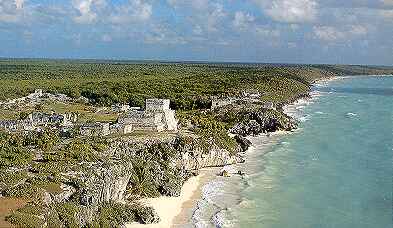 cannot go into Calica or Majahual when it’s this windy.
cannot go into Calica or Majahual when it’s this windy.
We arrived at Tulum before the crowds from Cancun arrived
there. That’s the way: get there early, it can get hot and crowded in the
afternoons.
The
name Tulum comes from the Yucatec word for "wall". It is likely that
the city’s original name was something like Zama or "city of the
dawn", which makes sense when you see the sites’ dramatic outlook toward
the east. Tulum claims the most privileged
panorama of the Yucatan's ruins. It is the only walled city near the ocean the
Mayans ever constructed. Built between 1200 and 1500 A.D., Tulum served as a
self-contained ceremonial center and trade port. The Mayas continued to live
here when the Spaniards sailed past in 1518.
We enter from a break in the
wall after taking the electric train from the entrance. It would be a short 15
minutes walk down a dirt road otherwise. Geraldo is a great guide, full of
information and good humor. After about 45 minutes, he lets us loose to explore
on our own.
Tulum is one of the most fascinating archaeological sites in the State of
Quintana Roo. Tulum, 130 km south of Cancún, considered by many as the most beautiful
of the Mayan sites, is small but exquisitely poised on the fifteen-meter-high
cliffs above the Caribbean. When the Spanish first set eyes on the place in
1518, they considered it as large and beautiful a city as Seville, Spain. They
were, perhaps misled by their dreams of El Dorado, by the glory of its position,
and by the brightly painted facades of the buildings. Architecturally, Tulum is
no match for these great cities. Nevertheless, thanks to the setting, it sticks
in the memory like no other.
It is located on the Caribbean coast of Mexico, 42 km
south of Coba via highway 307. Tulum was strategically
built on a cliff overlooking the Caribbean Sea.
Rising
at the edge of a 40-foot cliff is "El Castillo," the main castle
overlooking the Caribbean's turquoise waters. Among the city's significant
structures are the "Templo de los Frescos," a collection of elaborate
wall paintings decorated with masks and used as a place of worship. The
“Templo del dios Descente " act as a shrine with a carving of the ancient
deity, Itzamna. Over 60 buildings still remain inside the magnificent city
walls. Tulum’s fame for fascinating beauty and archaeological significance
make it one of the most visited wonders on the Corridor.
The site (open daily from 8am-5pm) is about one km from the main road, so make sure to get off at the turnoff to the ruins and not at the actual village of Tulum a few kilometers farther on. You enter through a breach in the wall, which protected the city on three sides. The sea defended the fourth side. This wall, some 5m (16ft) high with a walkway around the top, may have been defensive, but more likely its prime purpose was to distinguish the ceremonial and administrative zone (the site you see now) from the residential enclaves, which were mostly constructed of perishable material. As you go through the walls, the chief structures lie directly ahead of you, with The Castillo (The Castle) rising on its rocky prominence above the sea.
At
The Templo de los Frescos (Temple of the Frescoes), the partly restored murals
that can be seen inside the temple depict Mayan Gods and symbols of nature's
fertility; rain, corn and fish. They originally adorned an earlier structure and
have been preserved by the construction of a gallery around them, and still
later (during the fifteenth century) by the addition of a second temple.
Characteristically, its walls slope outwards at the top. Carved on the corners
of the gallery are masks of Chac, or perhaps of the creator, God Itzamna. The
Castillo, on the highest part of the site, commands imposing views in every
direction. Aside from its role as a temple, it may well have served as a beacon
or lighthouse. Even without a light it would have been and important landmark
for mariners along an otherwise monotonously featureless coastline. You climb
first to a small square, in the middle of which stood an altar, before climbing
the broad stairway to the top of the castle itself.
To
the left of this plaza stands the Templo del Dios Descendente. The diving or
descending god-depicted here above the narrow entrance of the temple appears all
over Tulum as a small, upside-down figure. His exact significance is not known.
He may represent the setting sun, rain, lightning, or he may be the Bee God,
since honey was one of the Mayan's most important exports. Opposite is the
Templo de Las Series Iniciales (Temple of the Initial Series), so called because
in it was found a steal bearing a date well before the foundation of the city,
and presumably brought here from else where. Further interesting places to
explore are strung out south along the coast. If you simply want to take time
out for a swim, you can plunge into the Caribbean straight from the beach
fronting the site.
Many of the all day tours from Cancun stop at Xel-Ha or Xcaret in the afternoon.
Xel-Ha
Xel-Ha
began as a port, but on a larger scale. Once the largest city on the coast, its
influence stretches to the Teotihuacan culture of central Mexico. Several murals
on the site depicting interaction between the people of Xel-Ha and the
Teotihuacan suggest a possible trade route between the two areas. Xel-Ha,
meaning, "Where the water is born," is often recognized as a microcosm
of natural beauty. Visitors frequently travel here to experience the
kaleidoscopic natural limestone pools, cenotes and natural sinkholes that
create an ideal atmosphere for snorkeling. Exotic parrotfish, angelfish,
butterfly fish and over 50 species of aquatic and plant life populate the pools.
Xel-Ha’s opulent natural aquarium, stunning murals and ruins provide a gateway
to the vast natural wonders of Meso America.
Xcaret
Xcaret
was once an important commercial and ceremonial center. The Mayans made
pilgrimages from this port and others along the coast to the island of Cozumel
to worship the shrines of Ixchel, the goddess of childbirth. From 1250 to 1521
A.D., Xcaret was used as a distribution point former chandise arriving from the
Caribbean. Abandoned long after the conquest, Xcaret was reincarnated by
developers in the 1980’s and is now an incredible eco-archaeological park.
This park and many like it promote environmental awareness and have ignited a
spark in the Meso-American community. The Mayan world’s natural resources are
preserved in the park’s lush botanical garden, tropical pools and cenotes
(sacred wells, usually located in caves). Xcaret’s wildlife refuge houses an
abundant array of endangered species like the jaguar, ocelot, spider monkey,
toucan, and macaw. Horseback riding, swimming with dolphins and discovering the
ancient Mayan ruins are among the varied activities to be found here. An
excursion to Xcaret will leave you with an educational and enriching glimpse
into the necessity of preserving our natural resources.
We stopped at the Melia Paraiso in Puerto Morelos first to let off a couple, who was staying there for a few days. Then we stopped at the airport before our hotel. It was great to get a ride to our hotel in Cancun.
Melia Turquesa
LOCATION: Bvd. Kukulcan, km. 12 Zona Hotelera, Cancun, MEXICO
|
Hotel data |
PHONE: 52 998812500
|
HOTEL DESCRIPTION: |
|
|
The hotel is nestled between the beautiful turquoise ocean and
the sparkling Laguna Nichupte on a beautiful white-sand beach. 12 km
distance from Cancún, the gateway to Mayan culture. Its close proximity
to the ruins of Tulum and Cobá, Isla Mujeres and Cozumel, make it the
ideal leisure center, offering a perfect mix of relaxation and culture. 20
minutes from the international airport. |
Distributed
on 11 floors, the hotel provides a total of 450 rooms, including 32 Junior
Suites with Jacuzzi, 2 Master Suites and 2 Presidential Suites. All of the rooms
have a private balcony offering fantastic views, a full bathroom with
hair-dryer, air-conditioning, satellite color TV, movies, telephone, mini-bar
and in-room safety deposit box. Room Service until 11 p.m.
We
got a nice ocean front room on the 9th floor. What a view! WOW! The
waves are wild today. We take a walk along the beach and see the warnings of
strong undercurrents posted in front of all the hotels. The lifeguards are busy
blowing their whistles to get people to not go too far out in the water. Walking
north the waves are so big and the wind so strong we get totally drenched, so we
turn around and walk south instead. The beach is not very wide against the
seawalls in front of the hotels north of the Melia Turquesa. The beach is much
wider to the south. The salt spray is totally covering my glasses and I can’t
see without continuously wiping them clean. It’s wild today. We wanted to stop
and rest at the Royal resort, because they have a nice outdoor restaurant/bar,
but they won’t let us order a beer and pay cash because we aren’t staying
there. Seems goofy! So, we walk back to our hotel and enjoy the view from our
balcony. Soon, the sky turns black and it starts to rain, it’s wild. It poured
for hours, so we had dinner at the hotel instead of venturing out. The waves
breaking sounds like thunder. I love it. We leave the balcony door open all
night. I love the sound of the sea and the waves crashing onto the shore.
Day 11: Monday Feb. 17
Return
to Seattle: Travel All Day
We
had a great night’s sleep and feel ready for the long flights home. It’s
been another great trip.
Alaska
Airlines #199: Depart: Cancun at 10:41 a.m. Arrive: Los Angeles at 2:10 p.m.
Seats: 22A&C
Alaska Airlines #471: Depart: Los Angeles at 4:40 p.m. Arrive: Seattle/Tacoma at 7:23 p.m. Seats: 10F&D

